This page is meant to complement the original Derby Works page created on this website, in that the original page now focuses on the period of the 1970's/1980's - essentially when I most visited the Works and for which many other photographers have supplied material.
The material on this page represents a walk through the years at Derby during its diesel days, though obviously with a bias to the post-Modernisation years! This is most definately a work-in-progress so please bear with me as new material is added, old material is rescanned and the captions updated.
![]()
1960
The order books for 1960 for Derby Works comprised fifty seven Type 4s similar to the D1 series, to be numbered D11 - D67 and thirty seven BR/Sulzer Type 2s numbered D5114 - D5150. As for the shunters Derby would be responsible for D3937 - D3946 for the North Eastern Region and D3947 - D4027 for the Western Region.
Into the New Year the Class 24s had reached D5073, with the shunters up to D3939. The variety of engines visiting Derby Works continued, some for repair and some for acceptance. The former included ED4, ED6, 12098, D2910, D5002, six Metro Vick Co-Bos, the latter included D8215 - D8217. One unfortunate visitor was D5014, sent up from the Southern Region with collision damage.
Production during February was moving right along, with D10 now released into traffic the Works set to with the new Type 4s D11 - D13, the shunters were up to D3945 whilst, with the setting up of D5075 the production line moved on to D5114 - D5119. This new batch of Type 2s featured the revised cab/headcode box design.
During March Derby Works had D3941 - D3958 in various stages of construction, Type 4 production had reached D14 and the Type 2s were up to D5119. The Works were repairing a great variety of steam and diesel locomotives. The Works still contained a fair number of withdrawn steam locomotives, whilst in the Klondyke sidings Fell locomotive 10100 was slowly being stripped of parts.
Mainline diesel construction slowed a little in April but the shunter line had advanced to D3964.
May found the Type 4 production still not advanced beyond D14, however for the Type 2s construction was up to D5123 and the shunters were well advanced to D3977. The first two Type 2s of the Scottish order, D5114 & D5115 were dispatched at this time to Scotland. Locomotives under repair now included an example of the English Electric Type 4 with D214, other types under repair included D2221, D5700 & D8018. Rotting in the yard were 10100 & 10800, steam repairs were still considerable whilst the accumlation of stored and withdrawn locomotives showed no let-up.
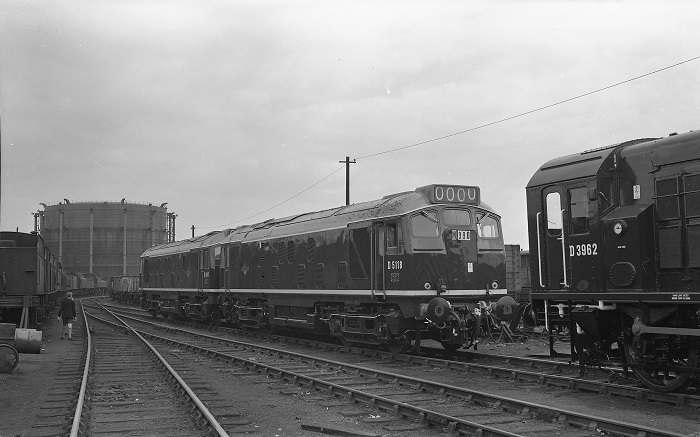
Production during June was well advanced for the Type 2s with frames now in place up to D5133, the shunter order had reached D3988 whilst work on the Type 4s continued to advance slowly. Locomotives under repair included D216, D5005 & D5019, D8007 & D8008. At this point the availability of the Metro-Vick Co-Bos had reached an all time low with many sidelined at Derby shed.
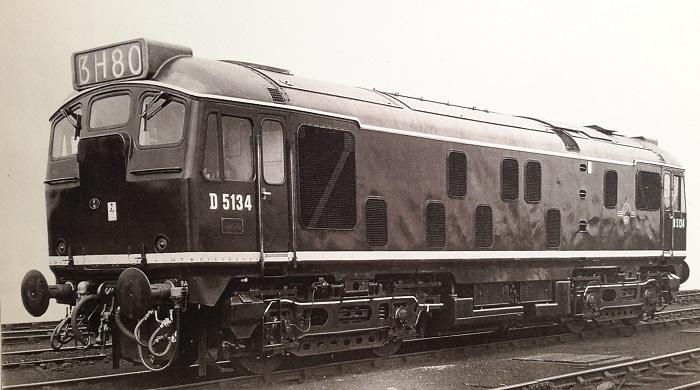
At the time of the Works annual two week holiday in July the Type 4 production was still at D14, shunter production had moved on to D3992 and the Type 2s were up to D5137. Throughout July many members of the Class 44s returned to Derby for attention. It was also during July that the remains of Fell locomotive 10100 were finally scrapped.
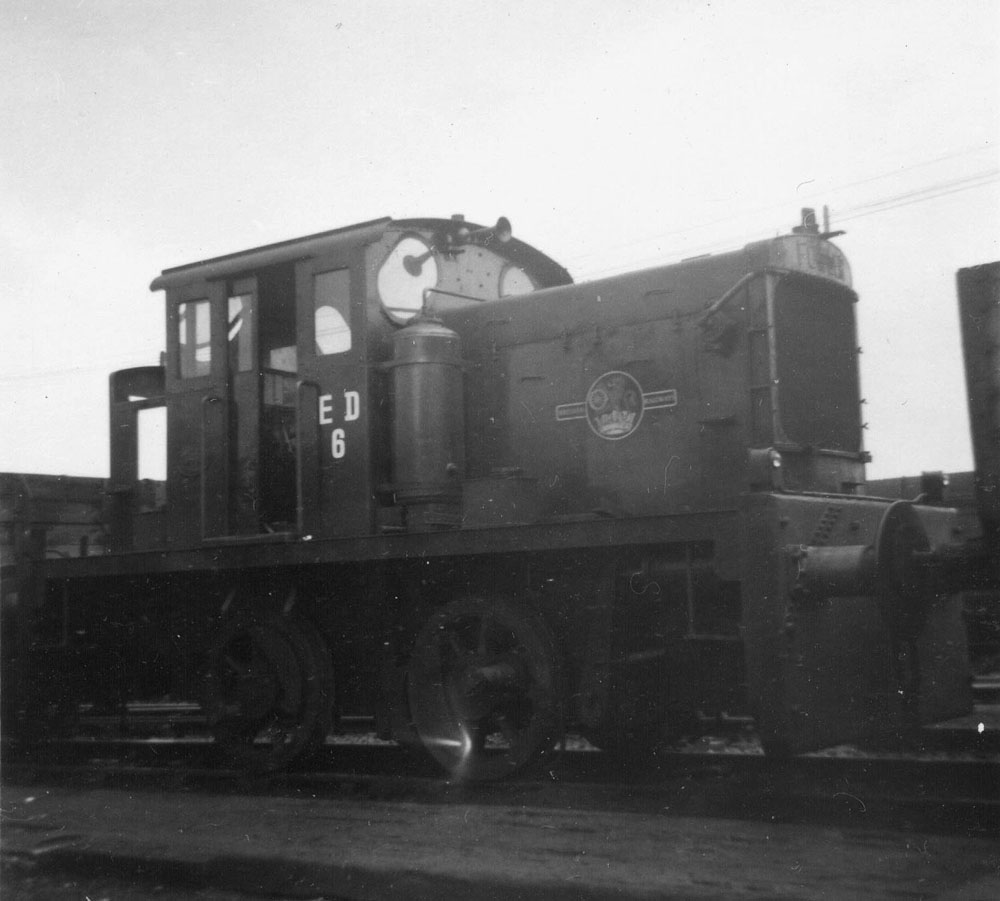
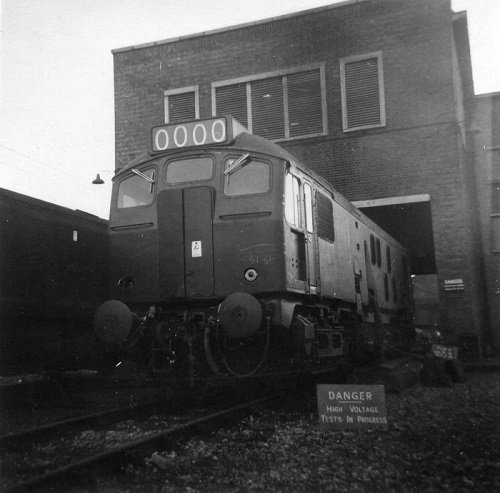
Upon return from the holidays the production of Type 4 D15 commenced, shunter production had reached D3995 and the Type 2s were up to D5140. A visit to the Works in the middle of August produced fifty seven steam locomotives, either in service or retired. At least twenty one diesels were on the Works (excluding the new builds) comprised of eight differents types.
The Works Open Day in August included ex-works Class 8P 4-6-2 No.71000 Duke of Gloucester, 5MT 4-6-0 No. 73135 and brand new Class 24 No.D5129 and shunter D3988 on display in front of the office block.
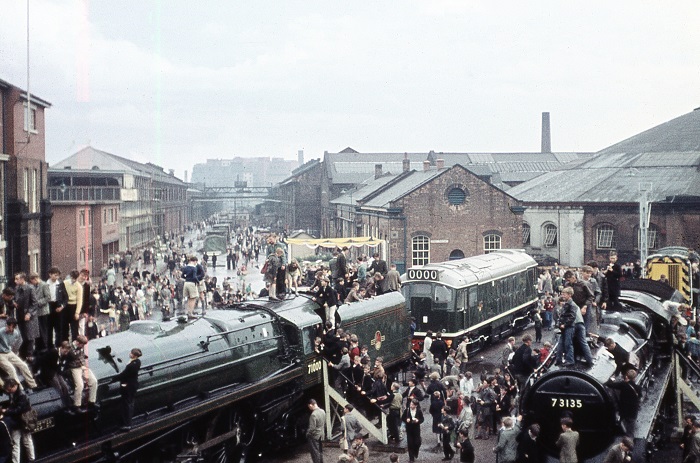
Other locomotives on Works at the Open Day were:
Main Erecting Shop:
47003, 47344, 73144, 48286, 44437, 42359, 47590, 73128, 42697, 43942
D13, D14
D3994, D3995, D3996, D3997, D3998, D3999, D4000, D4001, D4002
42344, 42184, 42101, 48770, 48083, 44184, 42352, 42096, 42338, 42740, 42542, 42532, 42111
New Diesel Shop:
D5135, D5136, D5137, D5138, D5139, D5140, D5141, D5142
D12, D15, D16
Paint Shop
48523, D3989, D3990, 42210, D5130
Diesel Maintenance
D2906, D8009, D5704, D3066, D3374, 12087, 13118, 12033, 12051, D5717, D5076, ED6
Diesel Test House
D3991, D3992, D5131, D5718, 10000, D5702, D232, D5080
Yard:
ED2, 42074, D3986, 42102, 42069, 42384, 42283, 42067, 40489?, 47203, 48388, 43394, 10800
Diesel Finishing Shop:
D3993, D5132, D7511, D5134, D11, D5133
Elsewhere on Work:
75055, 48096, 41726, 42238, 75049, 42089.
Across at the steam shed there were almost 100 steam & diesel locomotives present.
September saw a slowdown in the new build production, with only the shunter line advanced to D4001. Visitors for repair in September included 10000, D2906, D5702 and D8009. Withdrawn 10800 still lingered in the Works yard.
By October the production lines had picked up somewhat, the Type 4s were now up to D18, Derby finally having released its first two, D11 & D12 to traffic; shunter production had reached D4006 and the Type 2 construction line now included the last of this build, D5150. During this period there was a considerable influx of the English Electric Type 4s through Derby for repair.
Into November the Type 4 build had reached D20 and shunter production was up to D4010, although the order was originally to D4027, the batch from D4011 to D4027 were now transferred to Horwich. As well as working hard to complete its Type 2 order Derby was now handling many repairs to the Crewe built Type 2s.
As the year closed out so the production work on the shunter and Type 2 lines was focused on completing the final members of the respective orders. Perhaps because of this the Type 4 line had quickened pace with construction now having reached D24. Amongst the many steam locomotives dealt with by Derby during December was 9F 92030.
![]()
1961
The New Year brought further Type 4 construction with frames laid up to D28. The Works had outshopped the last of its 0-6-0 shunter order whilst the final Type 2's were nearing completion. Withdrawn 10800 was moved into the Workshops for removal of its power unit prior to the locomotive being taken to Brush Electrical Engineering Co Ltd, Loughborough.
To assist the Works in its painting of diesel locomotive a new paint shop was now under construction. This new three road building was 162 feet long and was located next to the Brass Finishing shop.
By February Type 4 construction had reached D30 whilst the last of the Type 2 order, D5150 was on the Test House. There was a myriad of steam & diesel locomotive types on the Works, from the diminutive ED2 to 9F 92129. There were no Metro Vick D57xx series locomotives in the Works at this time.
Compared to the output of Crewe Works and its BR/Sulzer Type 4's that of Derby seemed almost snail like, during March Crewe outshopped six, whilst Derby outshopped just one, this was D21 which happened to be the 700th diesel locomotive built at Derby. Also outshopped was the last of the Type 2 order, D5150 to Gateshead. During March Derby had frames up to D33 in place. The huge variety of diesels under repair included 10202 & 10203, 12000, ED4, D9, D221, D2501, D2910, D5092, D8006, 11116 & 12077.
During April construction of the Type 4's picked up with work now progressing as far as D37. An interesting contrast in the Works sidings was 12000 & D5701.
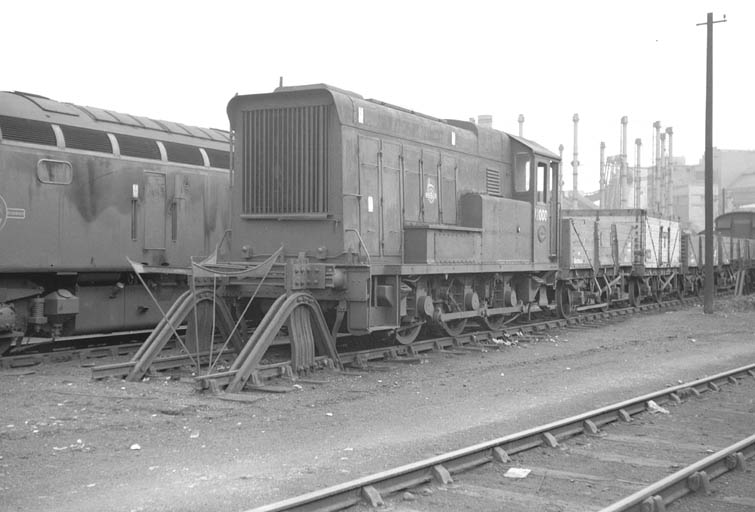

For the moment the only production line at Derby was for the Type 4's and by May that was progressing well with frames laid up to D43. Repairs were being undertaken to a great variety of diesel locomotives, thirty seven diesels were noted under repair during the middle of May, representing at least nine different diesel classes.
By June the Type 4 construction had reached the end of the order, with frames laid up to D49. The quantity and variety of diesels under repair remained at a high level, whilst the repair of steam locomotives continued at a steady rate. A milestone of sorts was reached on June 20th when D34 was outshopped from the Works and reported as the 1,000th main line diesel locomotive delivered under the Modernisation Plan of 1955.
With Derby's existing Type 4 order 'completed' new frames were laid for a further order of fifty six Type 4's starting with D138 and to be equipped with Brush electrical equipment rather than that of Crompton Parkinson. By the time of the July Works holiday the frames had been laid up to D141. Locomotives under repair included three named English Electric Type 4's; D214, D230 & D232. Although some of this Class were named at special ceremonies many received their nameplares whilst in the Works, since Derby made the nameplates it must be assumed that they were also fitted here. Also present for repair was 10203.
During August the Type 4 frames were laid up to D143, the Works was the usual mix of steam & diesel repairs.
The Annual Works open day during August included maroon liveried 46254 City of Stoke-on-Trent, 92220 Evening Star, a brand new Class 45 and a breakdown crane in the viewing area.
By September the Type 4 frames were up to D147, whilst the first of this build, D138 was nearing completion. Under repair were an eclectic mix of diesel and steam locomotives, in particular a fine cross-section of many diesel locomotive types operated by the London Midland Region. Examples of the diesels under repair included D1, D211, D2503, D2913, D5075, D8015, 11146, 12096, 13176. Out in the Works yard were 10202, 10203 & 12000. Also present on September 19th was a very sharp looking D100 'Sherwood Forester' which had been specially cleaned up for its naming ceremomy at Derby station on September 23rd. The regimental badges had been transferred from Royal Scot 46112 which was on Derby shed on September 19th.
Type 4 frames had reached D151 by October, the huge variety of diesels under repair showed no signs of letting up. 10203 had now moved into the erecting shop joining the likes of D6, D211 & D5084. Elsewhere in the Works was pioneer D8000, whilst D49, the last of the Type 4 order had been released to traffic. Such was the workload at Derby that modifications for the earlier build of the BR/Sulzer Type 4's were to be effected at Horwich Works.
The order books started to become active again with the announcement of an order for fifty seven sets of engines and transmission equipment from Sulzer/AEI for Type 2's D5176 - D5232 to be built at Derby & Darlington. Also noted was the return of the Metro Vick Co-Bo's to their makers at Dukinfield for modifications, once outshopped from here they would not return to the Midland mainline, their new home would be in the Carlisle, Workington & Barrow area, future Works visits would be made to Crewe.
By November the first of the current Type 4 order, D138 had been released to traffic whilst construction had now reached up to D156. 10203 was still under repair whilst 10202 had now moved into the erecting shop.
During December Crewe was noted taking on the repair of BR/Sulzer Type 2's & 4's, presumably to relieve Derby of its heavy workload. Darlington was also assisting in the repair the increasing fleet of diesel locomotives.
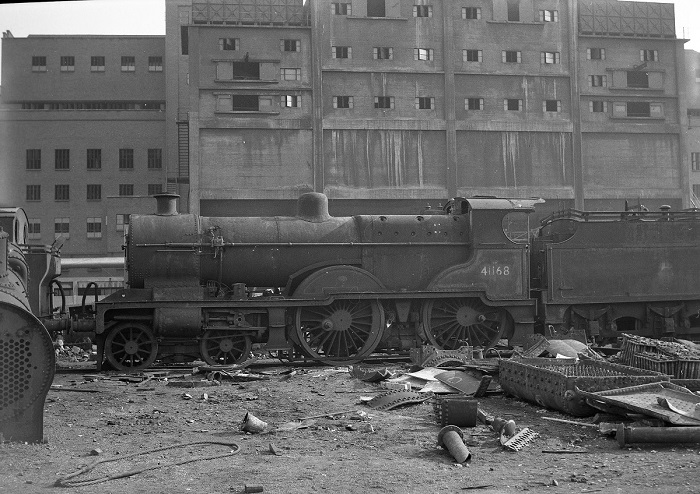
1962
As 1962 opened Derby still only had the one production line in operation, and that had now reached the early stages of construction of Type 4 D165, with D153 having just been released to traffic.
February saw the Type 4 production line now up to D169, Derby was now just over halfway through this order of fifty six locomotives. For the last couple of months there had been a noted absence for repair of the English Electric Type 4's, there was however no shortage of the BR/Sulzer Type 2's & 4's for repair!
Despite the loss of the EE Type 4's to Crewe & Darlington for repair Derby Works continued to repair a huge variety of locomotives. The original Peaks, D1-D10 were transferred to Toton at this time so they would be regular visitors to Derby for the remainder of their lives, with Toton normally allowing one to be away in Works at any given time, during March D1, D2, & D3 were under repair. The Type 4 production line had reached D172 whilst D159 had been released to traffic.
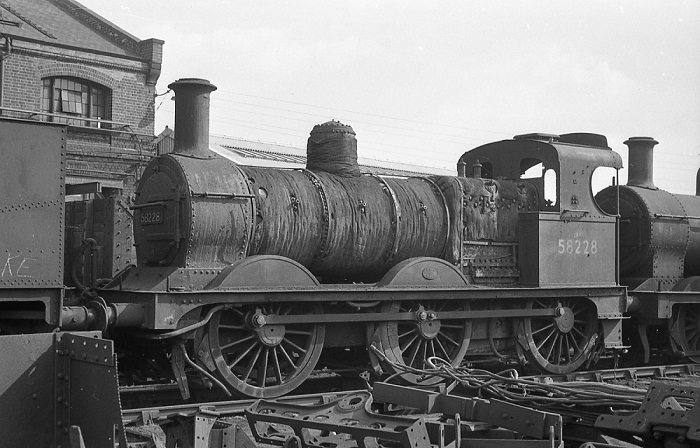
The only Type 4 of the present order to be named was D163 'Leicestershire and Derbyshire Yeomanry', it was noted in the paint shop at Derby on April 6th, it would be officially named in a ceremony at Derby station on April 14th. Also present about the Works were fourteen BR/Sulzer Type 2's, Type 4 construction had reached D176. 10203 had also returned to the Works.
New visitors to the Works during May were two power cars (60091 & 60092) and two coaches from one of the Midland Blue Pullman sets. 10203 was still in the Works, whilst Type 4 production had reached D180.
During June the English Electric Type 4s returned to Derby, so noted was D310 under repair. A new arrival was 10201 whilst Type 4 construction had reached D185. Also during June early pioneer shunter 12000 was scrapped, but not without incident. The cutting up took place at the top of No.2 bay, before cutting the fuel tank free the cutter asked if it was certain the tank was empty? The response was in the affirmative - the gauge was on zero. However the gauge was an electric one that didn't show a level until energised. The pipe flange bolts were duly cut and whacked, 500 gallons of diesel poured into the pit, which drained into the River Derwent.
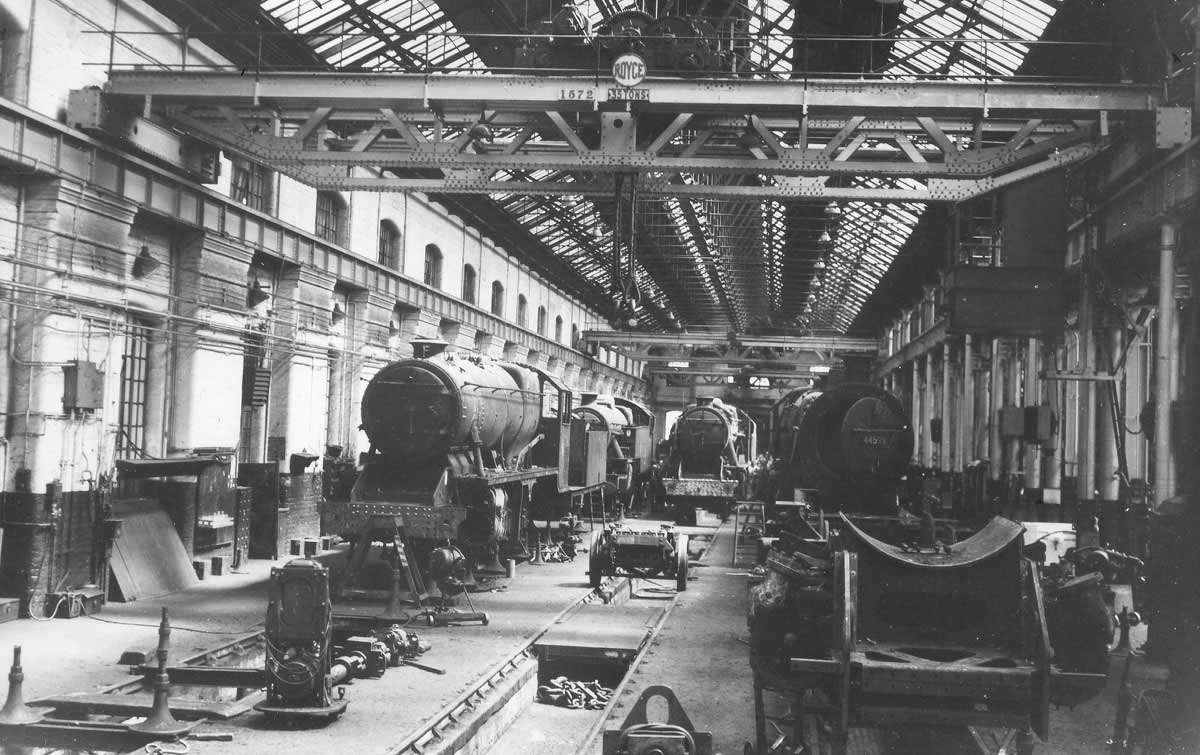
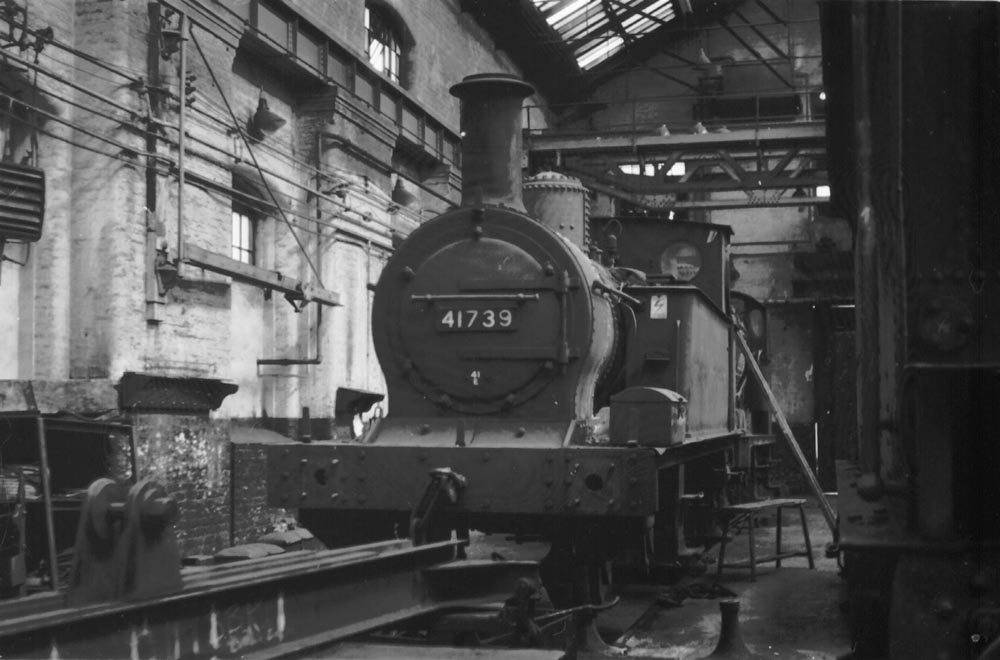
July brought another most unusual visitor to the Works, E3071 - one of the LMR A/C electric locomotives, it was noted in the diesel erecting shop surrounded almost entirely by BR/Sulzer Type 2's & 4's. The electric had arrived late in June spending time in the Research Department sidings before moving to the Works. 10201 & 10203 had migrated to Klondyke sidings whilst 0-6-0 shunter 12000, long withdrawn at Derby was almost completely scrapped. The Type 4 construction line was now up to D189, just four sets of frames remained to be laid.
By the end of August the last of the frames for the Type 4 order had been reached. Another Blue Pullman power car, M60090 had arrived on the Works, whilst locomotives under repair included ED3, D5, D2386, D5000, 12054 amongst many others. 10001 had also arrived on the Works. A considerable variety of steam was still being repaired at Derby, but the quantity was noticeably diminishing.
On display at the Works Open Day on a dry August 25th were Britannia 4-6-2 No.70048 The Territorial Army 1908-1958 and Coronation 4-6-2 No.46256 Sir William A Stanier FRS, alongside these two locomotives was a newly built Peak.
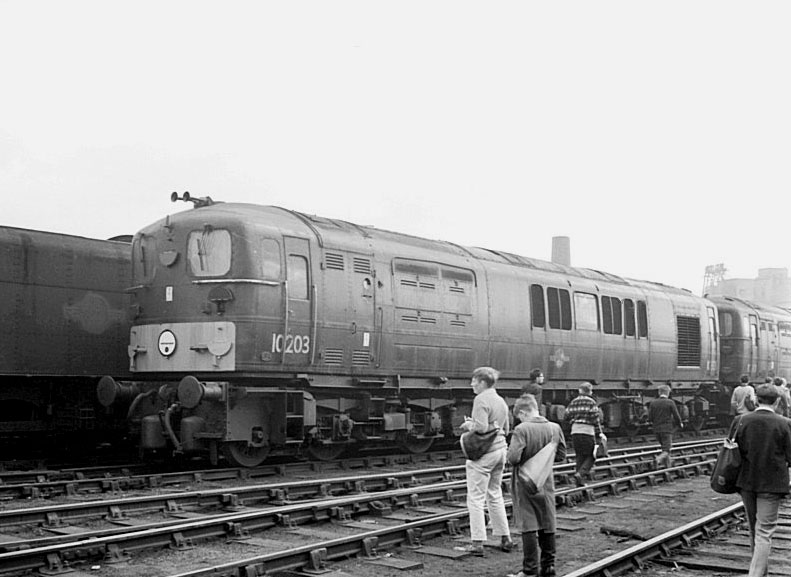
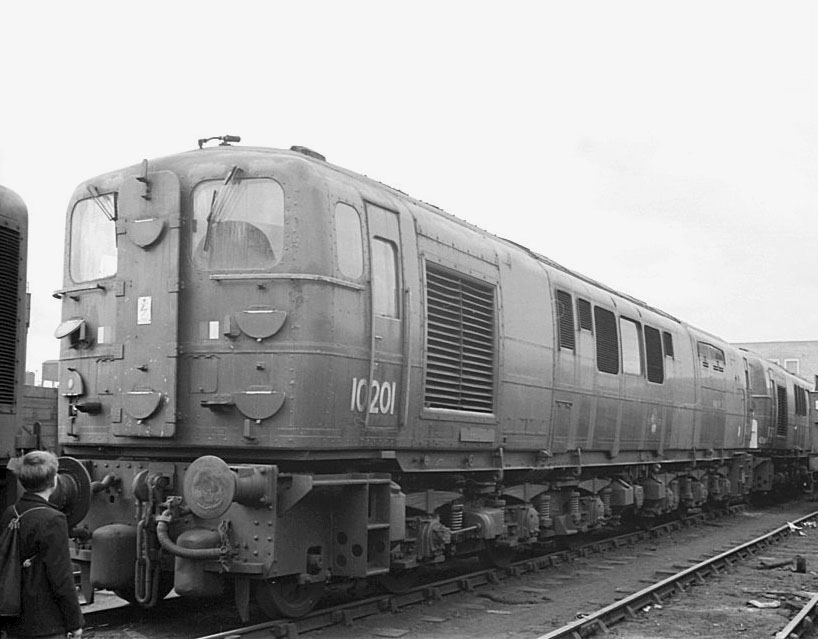
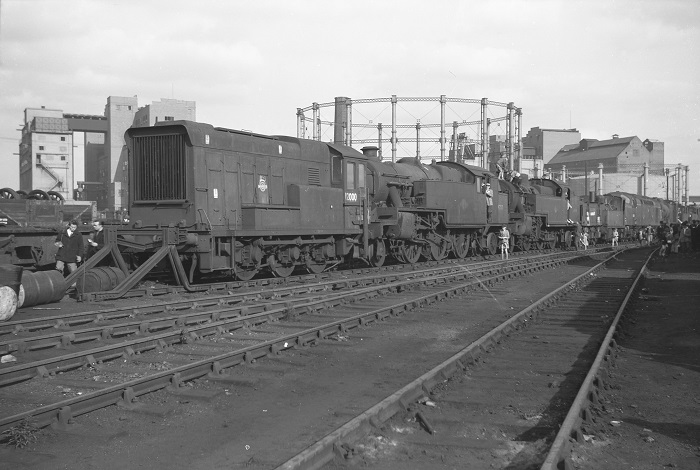
By September departmental No.ED7 (John Fowler 22891 of 1940) and latterly working at Fazakerley PAD, was recieved by Derby Works for overhaul. The repairs were not carried out and the small shunting locomotive was broken up at Derby during April 1964.
Towards the end of September the BTC announced proposals for the reorganisation of the railway workshops in light of the delivery of new locomotives and railcars in replacement of steam power and/or the reduction of routes and services. For Derby Locomotive Works there would be a modest increase in staff by 1963/64.
Orders were now in place for the production of 165 1,250hp Type 2 locomotives equipped with Sulzer engines and AEI transmission equipment, with Derby to be involved in a significant portion of the build. And with the Type 4 production line at Derby drawing to a close the first frames for the new Type 2's (order 4600) were laid at Derby during September commencing with D5186. Present in the Works were 10001 under repair, another Blue Pullman power car, M60093 and at least another twenty diesel locomotives on the premises.
At the end of October the Type 2 build had reached D5193 whilst the last seven new Type 4s were in various states of completion about the Works. 10201 & 10203 were now joined by 10202 in storage. Another Blue Pullman power car M60092 was under repair alongside many BR/Sulzer Type 2s and 4s and a mixed selection of diesel shunters. The Blue Pullman power car would be outshopped during the second week of January 1963. There were less than twenty steam locomotives on the Works and several of these were for scrap.
By the end of November Type 2 production had reached D5196 whilst the last four locomotives of the Type 4 build, D190 - D193 were very close to completion. However their places were quickly being taken by a great number of Type 4s for repair, twenty four were noted about the Works! A new type to visit the Works were members of the BRCW Type 2s now allocated to Cricklewood, noted for repair were D5390, D5394, D5400 & D5408. Steam repairs were definately dwindling, although one bright note was the repainting of Compound MR 1000 prior to delivery to the Clapham museum early in December, this locomotive had spent a number of years in store at Derby.
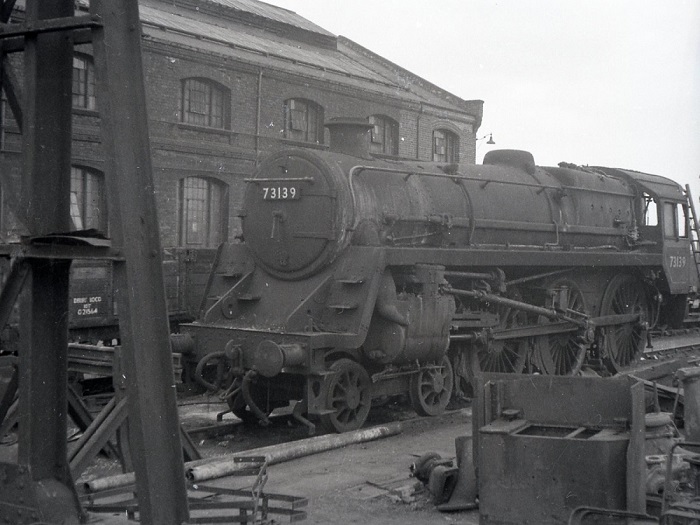
Late in 1962 10000 returned to Derby Works for the last time, it would spend a year at Derby prior to being officially withdrawn in December 1963.
![]()
1963
The memorable winter of 1962/1963 would impose a great strain on the Workshops as the extreme winter weather took its toll on the diesels, in particular the inability of the train heating boilers to perform in this lengthy period of arctic conditions. By the middle of January Derby Works held twenty five BR/Sulzer Type 4's, not including the final members of the class awaiting release. There were thirteen Type 2's in the Works including D5000, D5002 & D5003. The English Electric Type 4's were represented by D303. Pioneers 10000, 10201 - 10203 were now all lined up together, their working careers finished. New Type 2 construction had reached D5200.
At the beginning of February the Type 2 production line had reached D5204 whilst the Works had made progress in dealing with locomotives that had suffered due to the continuing cold and snowy weather. Steam locomotives on Works numbered thirteen and several of those were withdrawn.
During February the Scottish Region stopped delivery of the Clayton Type 1s whilst faults were addressed. Many were stored at Parkhead with some returned to the Clayton Works at Derby for attention. Of those returned to Derby eleven were stored at St Andrews Goods Yard whilst by late March others were stored alongside the steam shed. Not all the locomotives had received British Railways numbering. Examples were still present late into June 1963.
During March the Type 2 construction had reached D5210 whilst the first three of the build, D5186 - D5188 had finally been released to traffic. Twenty five Type 4's were under repair as was D5393 and Blue Pullman power car M60093.
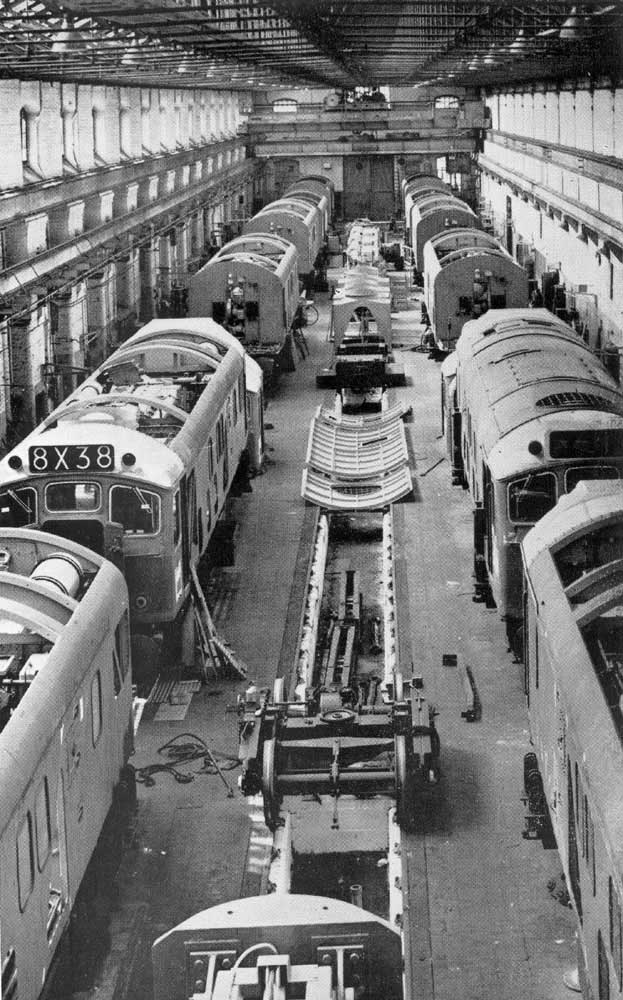
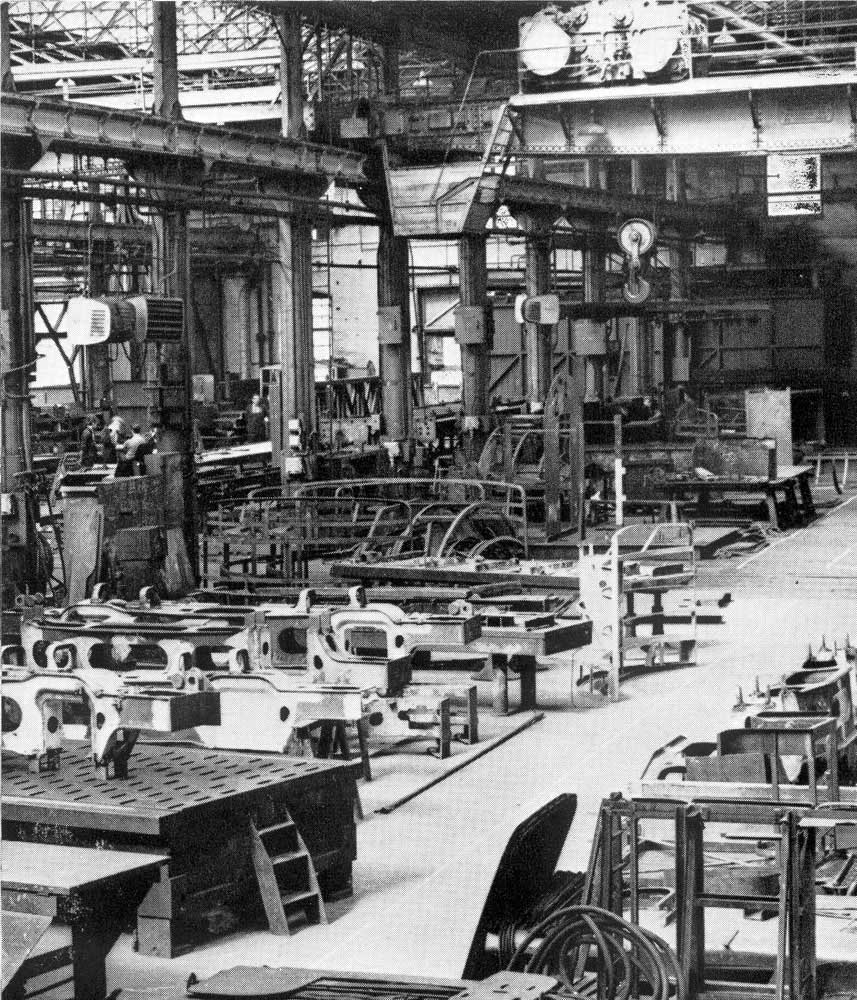
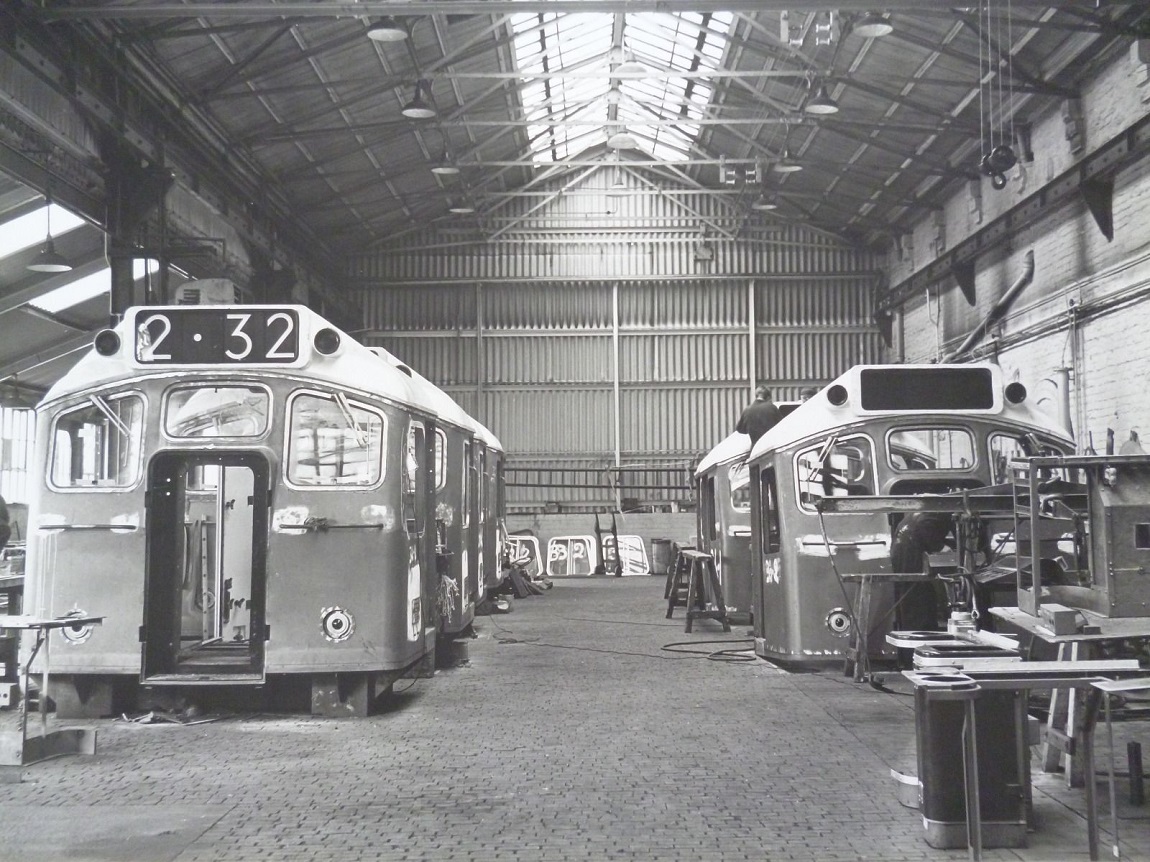
Repairs in April were at a very high level, shunter repairs were focused on the 0-6-0 Class 08's, but others included D2220 & D2913, there was also one BRCW Type 2 on Works, D5411. Type 2 production had reached D5216.
Part of Derby's Type 2 order (D5223 - D5232) was transferred away to Darlington at this time whilst Derby prepared to make changes to the external design of the future Type 2's. By the middle of May frames had been laid for the last of the current order, D5222 and the first of the new order, D7568. After the completion of locomotives D7568 - D7577 construction would recommence from D5233 which would feature the revised cab and body styling. Steam locomotives totalled twenty three, either for repair or scrap.
In the middle of June the Works contained sixty diesels under repair or for scrap and seventeen Type 2's in various stages of construction, which had now reached D7573. Included in the locos under repair were ED4, ED6, ED7 & D3, D4, D6 & D7. There were no English Electric powered mainline locomotives under repair.
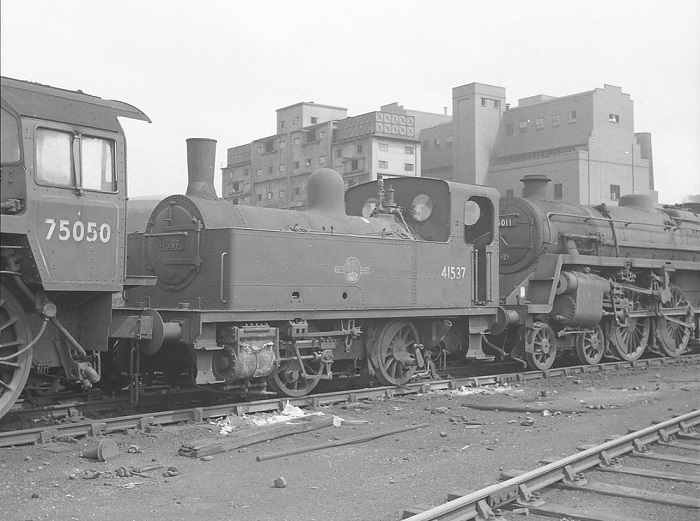
By the time of the Works holiday in July the Type 2 production had reached D7576. Eighteen steam locomotives were on Works of which about one third were withdrawn.
During August the Type 2 production line saw the laying of the frames for the last of the current order, D7577 and the first examples of the next order starting with D5233. This order would be the first to carry the revised body and cab modifications. There were over sixty diesels under repair or awaiting scrap including D2221, D2508, D2911, D5400, 13335 to identify but a few. Steam locomotives totalled fourteen, the greater majority of which were for breaking up.
The Works Open Day on August 31st produced the following locomotives on display in front of the office block:
D57, D2381, D3021, D5222, 44094, 46251 City of Nottingham & 47581.
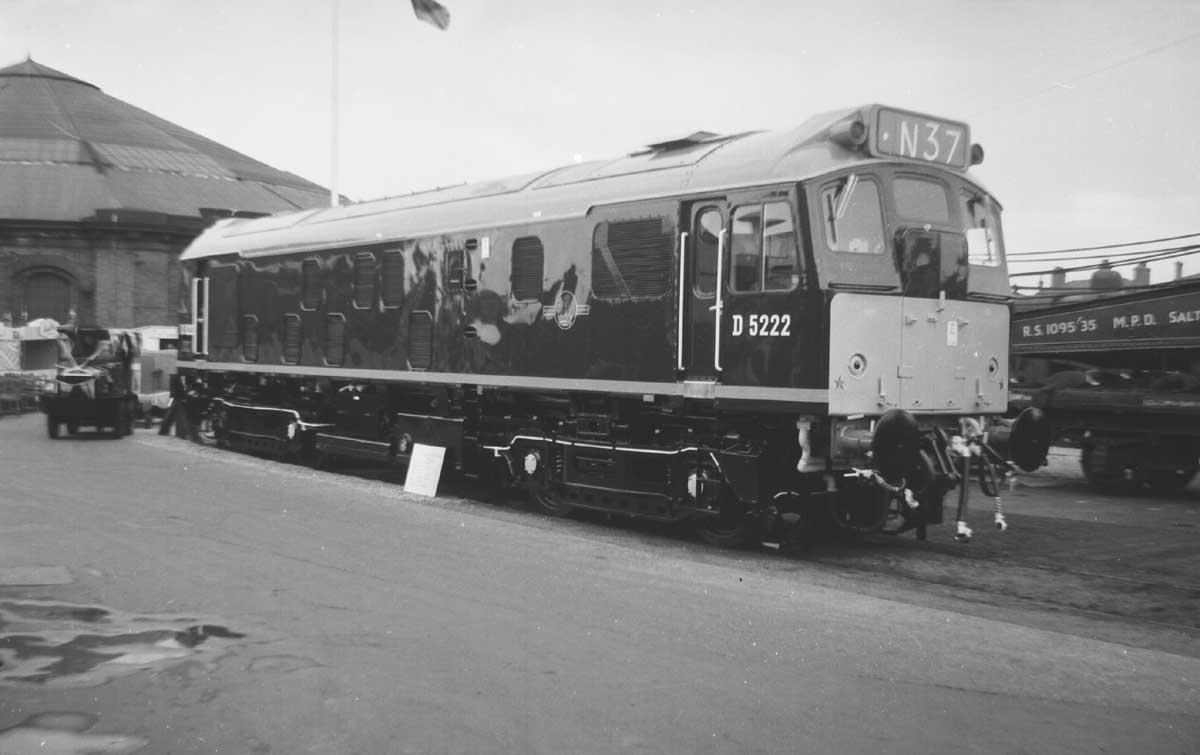
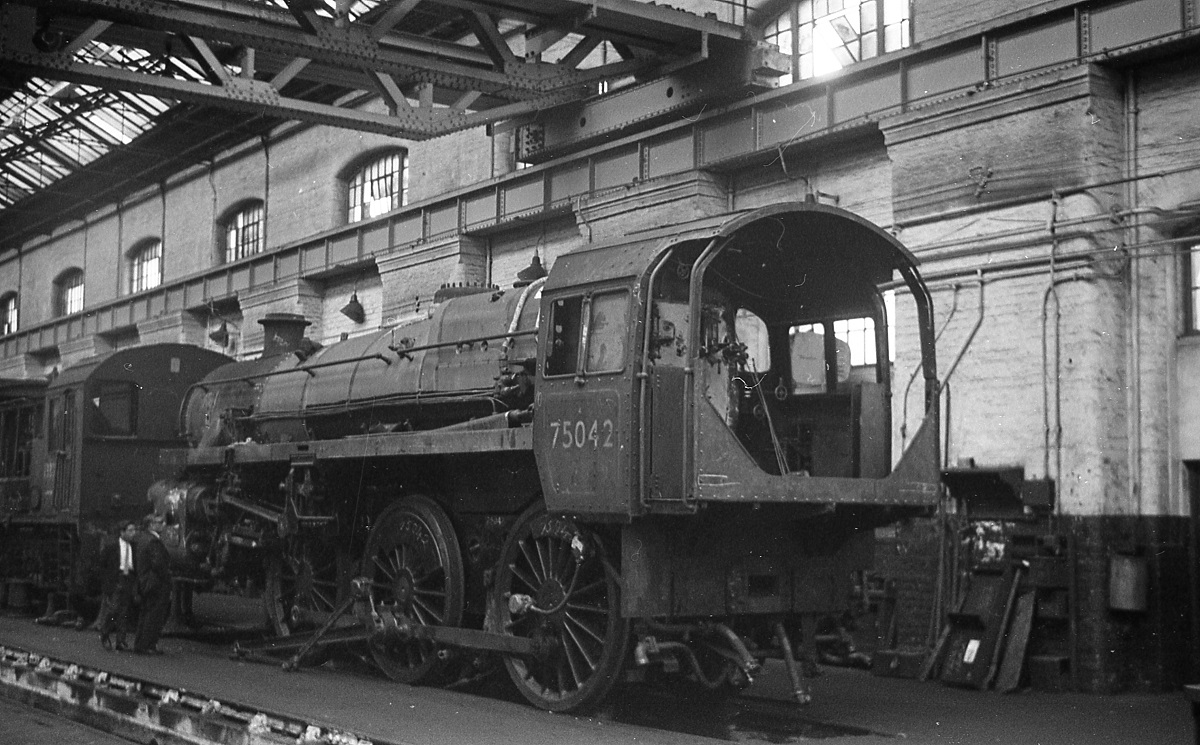
Such was the sign of the times that late in August a convoy of steam locomotives left Derby (shed?) for Crewe for repair, whilst on September 20th Class 4 75042 became the last steam locomotive to be overhauled at Derby Works. At the end of September steam locomotives remaining on the Works were 42231, 42500, 44416 & 44434. Type 2 production had reached D5247.
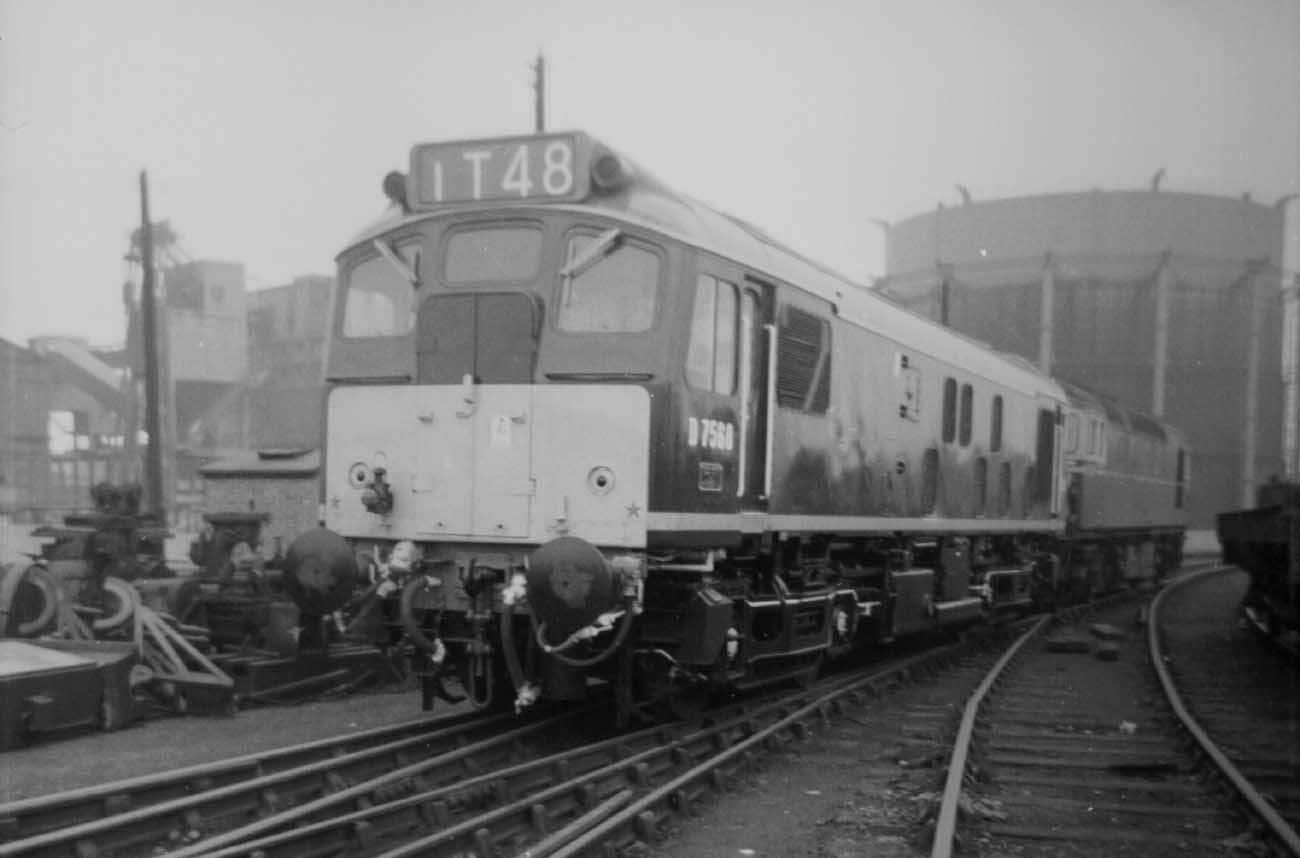
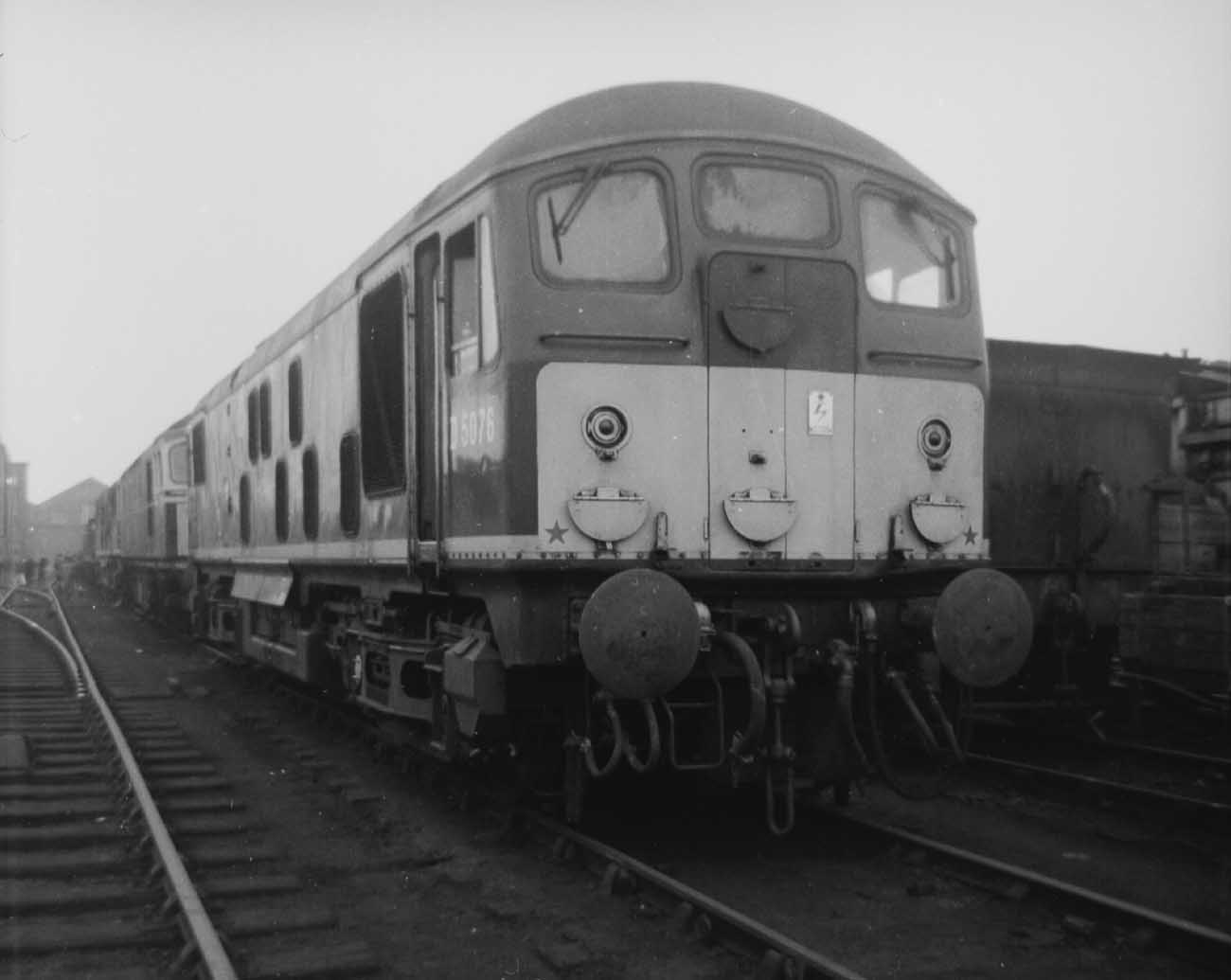
By the end of October Type 2 production had reached D5247. The Works contained a veritable mix of the BR/Sulzer Type 2's & 4's along with a great variety of diesel shunters. Steam locomotives included 42228, 42500, 43969, 44176, 44297, some of which were little more than parts in a wagon.
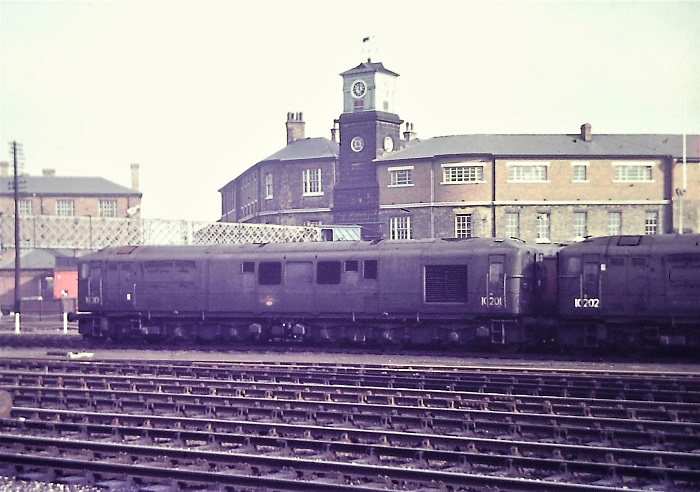
As 1963 closed Derby released to traffic the first seven of their Type 2's (D5233 - D5239) featuring the cleaned up body styling and revised cab fronts that no longer incorporated the gangway doors. Frames had now been laid up to D5252. The arrival of 10001 early in December for attention put all five of the existing early pioneers at Derby, although of course 10000, 10201 - 10203 had not turned a wheel for quite a while. Prior to their withdrawals spares for these pioneers power units had created huge problems, despite repairs all the units had failed in the test shop (liner leakage) - this led to the decision to withdraw them, though Ivatt tried to get 10000 preserved, but the BRB CM&EE decided against it. Additionally Clapham were lukewarm to the idea. BR then considered selling them to '3rd world countries' but felt that the repair costs were prohibitive. Amongst the large quantity of BR/Sulzer Type 2's & 4's on Works were shunters 12005, 12031, 12059, 12066, D5382, D5386 & D5402. Another new type to grace the Works were Brush Type 4's delivered from Loughborough in undercoat, Derby would finish the paint jobs, noted were D1698, D1701, D1707 & D1711. Steam locomotives on Works were 42500 & 44526.
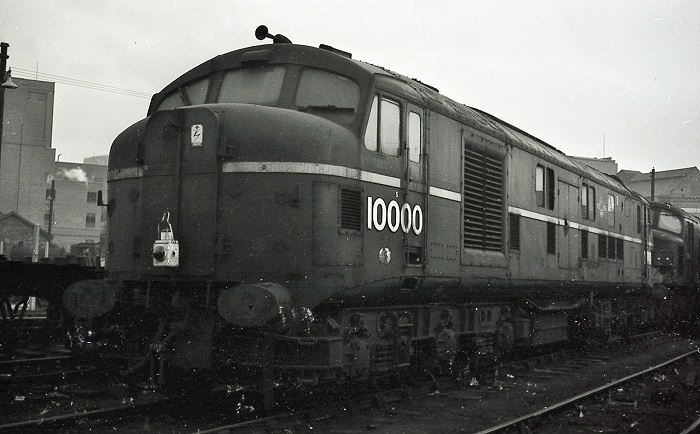
The following information comes from a booklet produced for a visit by the Duke of Edinburgh to the Locomotive Works during May 1964, the statistics refer back to 1963.
New locomotive output for 1963:
BR/Sulzer/Brush 2,500hp Type 4 mainline diesel electric - 5
BR/Sulzer/AEI 1,250hp Type 2 mainline diesel electric - 57
Scheduled output of new locomotives for 1964 - 75
Output of repaired locomotives for 1963: steam - 56; diesel - 617
Output of overhauled rail car equipment:
Repaired railcar engines - 1,238
Modified railcar engines - 104
Repaired gearboxes - 762
Repaired final drives - 577
Output of repaired mobile cranes:
Steam cranes - 6
Diesel cranes - 25
Other cranes - 3
Staff employed:
Works staff - 3,315
Accountant's department - 323
Stores department - 125
Current repair reponsibilities (diesel locomotives only)
Main line locomotives - 309
Shunting locomotives - 317
![]()
1964
At the end of January Type 2 construction had reached D5266. Loughborough had sent up D1715 for painting.
Small shunting locomotive ED7 which had been on Works since September 1962 was withdrawn during February and scrapped at the Works during April.
On Thursday May 14th HRH Prince Philip, Duke of Edinburgh paid a visit to Derby which included a visit to the Locomotive Works followed by the short journey to the newly constructed Engineering Research Laboratories to officially open them. A booklet produced specifically for the visit provided the following details:
For the Locomotive Works the Prince would arrive by car at the entrance to the Works Training School at 10.10am. A guided tour on foot included:
Planning Room
Diesel Railcar Engine Repair Shop and Test House
Machine & Fitting Shop
Locomotive Erecting Shop
Coppersmiths/Sheet Metalwork Shop
Plating and Welding Shop
Works Medical Centre
The tour would end at 11.15am with five minutes allowed to reach the Engineering Research Laboratories where the Opening Ceremony would commence at 11.23am, a tour of seven different sections commenced at 11.39am, ending at 12.45pm.
The route taken by Prince Phillip through the Works had been spruced up, they painted the Works where he would see the buildings and even polishing little used rails with emery. However Prince Philip being an ex-Navy man was not at all interested in the 'set pieces' and the associated fluff, in the diesel erecting shop he stopped for a chat with some of the staff alongside the stripping pits, asking the staff where they worked and hopefully if it was on his tour, when told no, the Prince told about his rail trip across Canada with the Elisabeth as he called her. The Prince then departed by car for a luncheon at the Midland Hotel at 1.00pm.
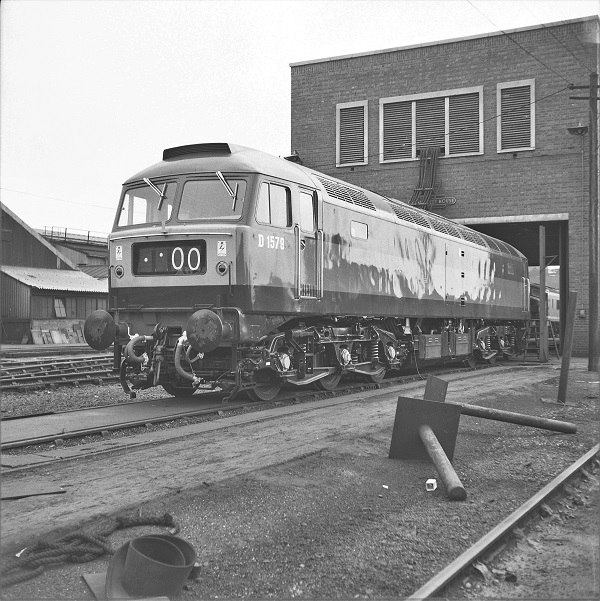
The end of May found almost eighty diesel locomotives under repair or pending scrapping, this number did not include the new build locomotives D5275 - D5292. Thirty three of those under repair were BR/Sulzer Type 4's. Present for painting was D1738 & D1740 whilst blue liveried D1733 was also present. Steam locomotive 42500 was also present.
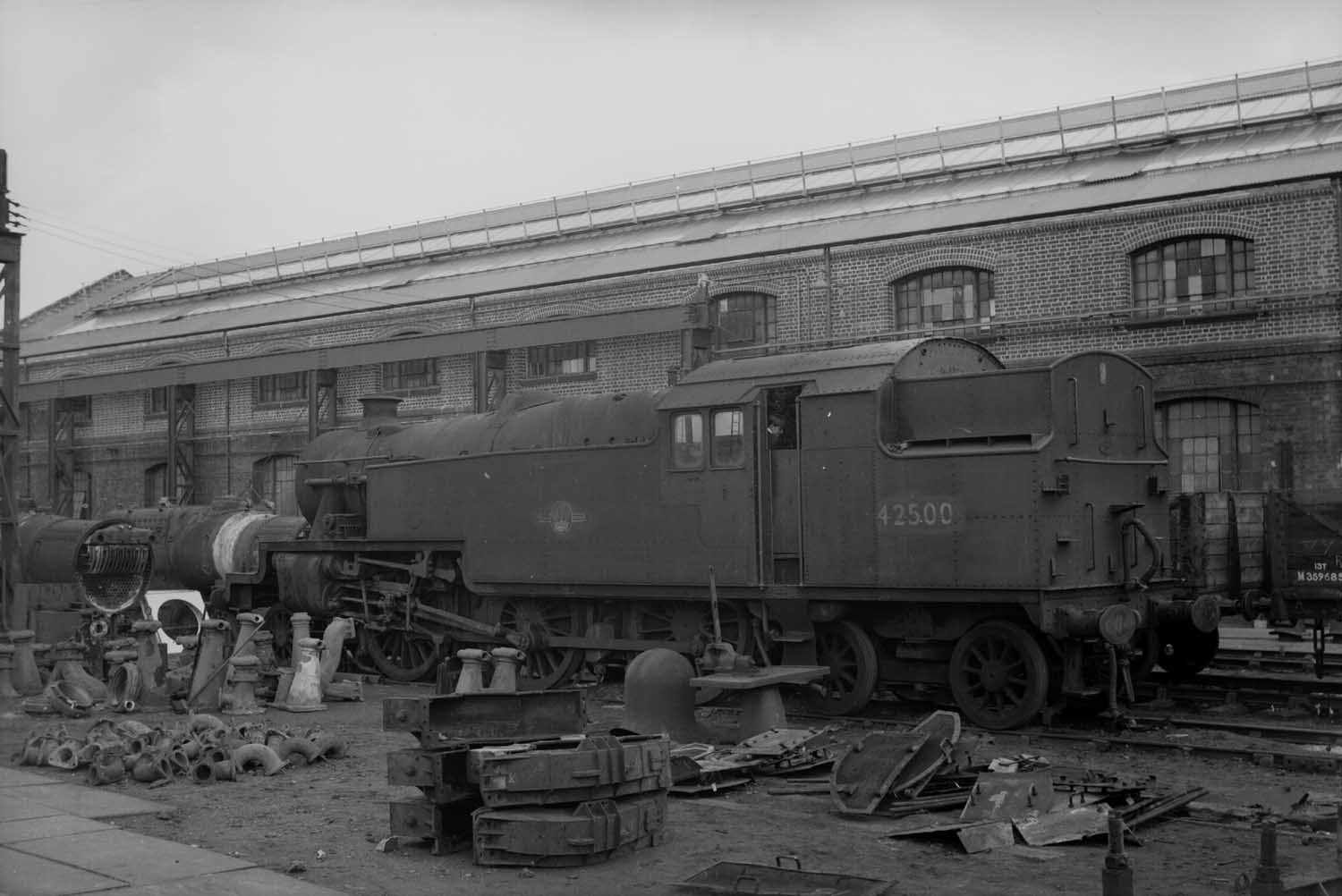
Another order for eighty BR/Sulzer Type 2s was received for D7598 - D7677 with the order to be split between Derby and Beyer Peacock.
By early July Type 2 construction had reached D5298 and moved over to D7500 - D7503. Construction of D5299 was deferred, it was intended for the new Sulzer six cylinder 'R' series engine. D1751 had arrived from Loughborough for painting. Shunters under repair included types represented by D2507, D2902 and 12013 as well as the many standard 0-6-0 Class 08 examples.
The Works Open Day on a delightfully sunny August 30th produced the following locomotives:
On display in front of the office block: D94, D1756, D3016, D5293, 92053, 46245 City of London
Erecting Shop: ED6, D105/164/176, D2502/06, D2900/02/04/09, D3168, D5026, D5381/83, D5404, 12032/44/50/68
Erecting Shop: (New Build): D5298, D7500-7503 (all complete), D7504-7512 (various stages of construction)
Diesel Finishing Shop: D124/166/173/175, D5297 (all inside), D133, D5192, D5296 (all outside)
Foundry Row: 10201/10203, 42500, D84, D168/186, D5017, D5261
Paint Shop: D5294
Klondyke: ED4, D18/19/44/78/80/92, D117/152/178/192, D2509, D3057, D3123, D3373, D3764, D5000, D5202, D5384/95, D5405, 10000, 10202
Test House area: D15/72, D114/156/179, D3118/3122, D5027/93, D5199, D5203/81, 12023
Repair Shop: D11/24/38/41/51/52/97, D107/121/172/183, D5077, D12016
Withdrawn steam engines present: 47320, 68013 & 45585
Interestingly on this day there were no Class 44s under repair and 20% of the Class 45/46 fleet were in the Works!
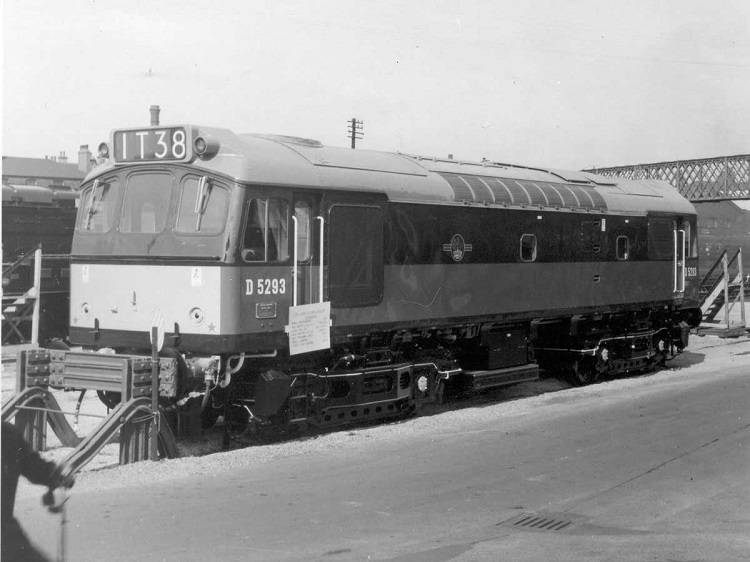
There were approximately ninety diesels on Works at the end of September. This did not include the new build Type 2s D5298, D7500 - D7518 in various stages of construction. D1767, D1702 & D1773 had been received from Loughborough for repainting whilst D1619 was in the Works yard attached to Dynamometer Car M45050.
On October 28th long time steam resident, preserved 42500 was towed south to Stratford, this left no steam locomotives on Works although many would still visit the nearby Derby shed. Type 2 production was up to D7524 and the repair side of the Works had almost ninety locomotives, though several of these were for scrap, including pioneers 10000, 10201 - 10203. Received from Loughborough for painting were D1783 whilst D1702 was still present.
At the beginning of December Type 2 production had reached D7533 whilst Loughborough had sent up D1790 for painting. Elsewhere the Works were littered with the BR/Sulzer Type 2's & 4's including Type 4 D9 and pioneer Type 2 D5000.
![]()
1965
At the very begininning of 1965 there were almost eighty diesel locomotives on the Works either under repair or awaiting scrapping. Additionally new Type 2's under construction were D7521 - D7539. In the paint shop was D1802 ex-Loughborough. Shunters present included D2218, D2900/02/10/12, 12005 & 12009.
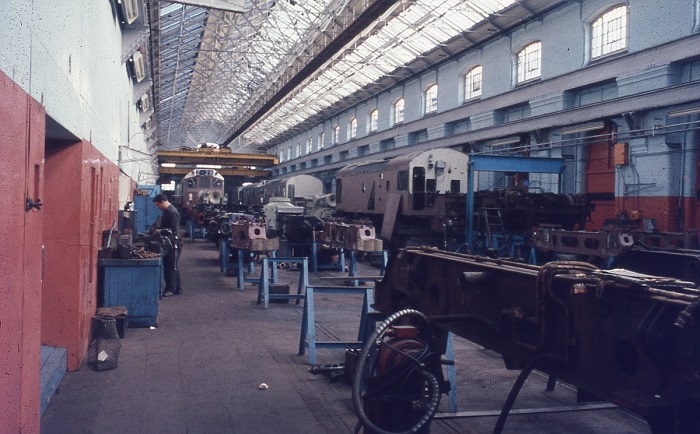
During April the Brush Works at Loughborough received a contract for the repair of certain British Railways diesel locomotives, in particular the Derby built Type 4s D138 - D193 which had been fitted with Brush Electrical equipment. This would certainly relieve Derby of some of its workload for the next four years, with D154 being the first to be received by Loughborough.
Derby had by the beginning of May reached D7559 in the Type 2 order. Amongst other Type 2s under repair were Thornaby & Gateshead allocated D5175 & D5182, normally Darlington would have handled these but Darlington was slowly winding down, now with less than a year to remain open. BRCW Type 2s in for repair included D5374 & D5379. Shunters included 12005/16/34/35/45/61/80/84. In the Works Yard was D1773 with Mobile Laboratory Coach No.1.
At the beginning of June Type 2 construction was up to D7562 whilst another North Eastern Region Type 2 to be received for repair was D5113. With Loughborough taking over repair of the later series Type 4's there were now fewer of these coming through Derby Works. Brush Type 4s received from Loughborough for painting were D1870 & D1876 whilst D1773 was still in the Works yard. This locomotive had been used on a special train of fourteen coaches and a Laboratory Van between Derby & Trafford Park on April 26th & May 6th.
Variety in the Works early in July was noted by the presence of Blue Pullman power car M60090 in the storage lines alongside D6, D5006 & D12022 whilst across in the paint shop was D1888. Another Gateshead type 2, D5102 was received for repair, whilst just outshopped in two tone green livery was D5038, one of several that would receive this treatment at Derby during the summer of 1965. This was the livery that Derby was using to outshop its new Type 2s and the unpainted Type 4's coming from Loughborough.
The period after the Works holiday saw the new Type 2 construction concentrating on locomotives up to D7567, the new build would begin at D7598 when the next frames were laid. Long withdrawn pioneers 10000 & 10201 - 10203 were still in the Works whilst a brief visit was received from still active 10001.
On display in the viewing area at the Annual Works open day during August were 70012 John of Gaunt, 92094 and a brand new Class 25 & 47.
During the last week of October pioneer 10001 was still on Works, but now noted in the diesel repair shop. Another noted visitor was D2513, the first of its type to visit the Works. Less fortunate was accident damaged D5383, this would become the first of the BRCW Type 2's to be withdrawn after its accident at East Langton. Frames had been laid for the first of the Type 2 order N10001, this would become D7598. And just released was D5299, intended to carry the Sulzer 'R' series engine, but now just a standard Type 2, the work on the 'R' series engine having been cancelled due to all the problems with the double bank 12LDA series engines.
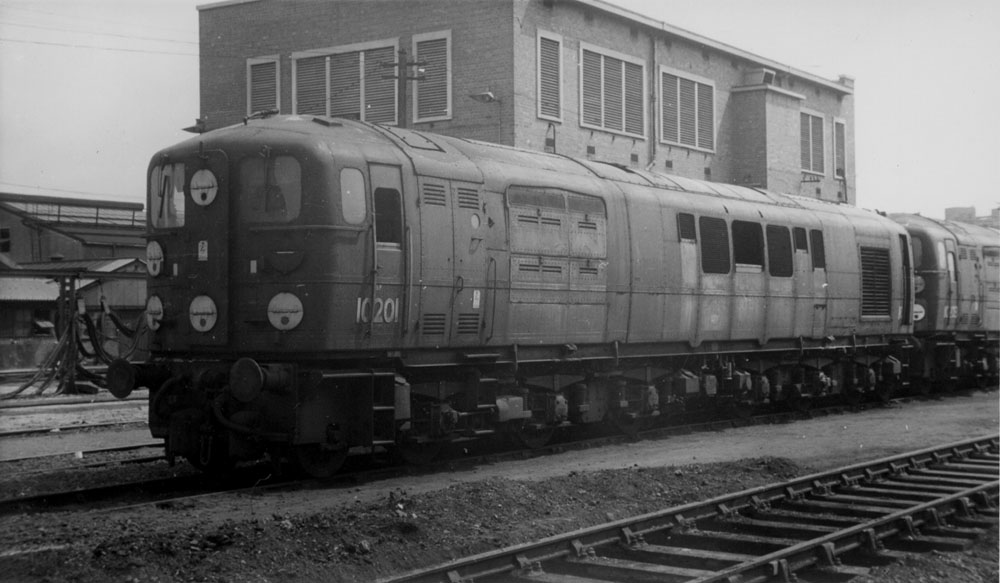
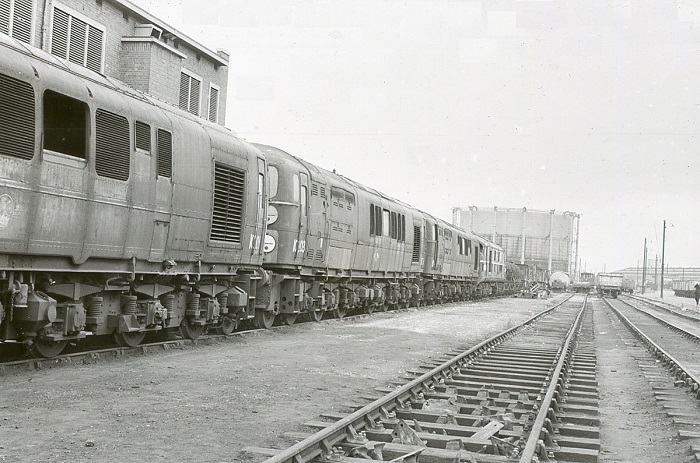
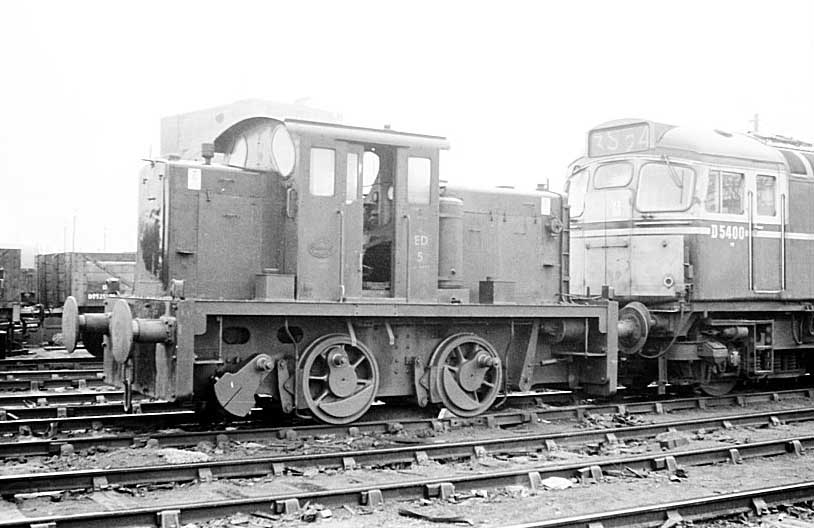
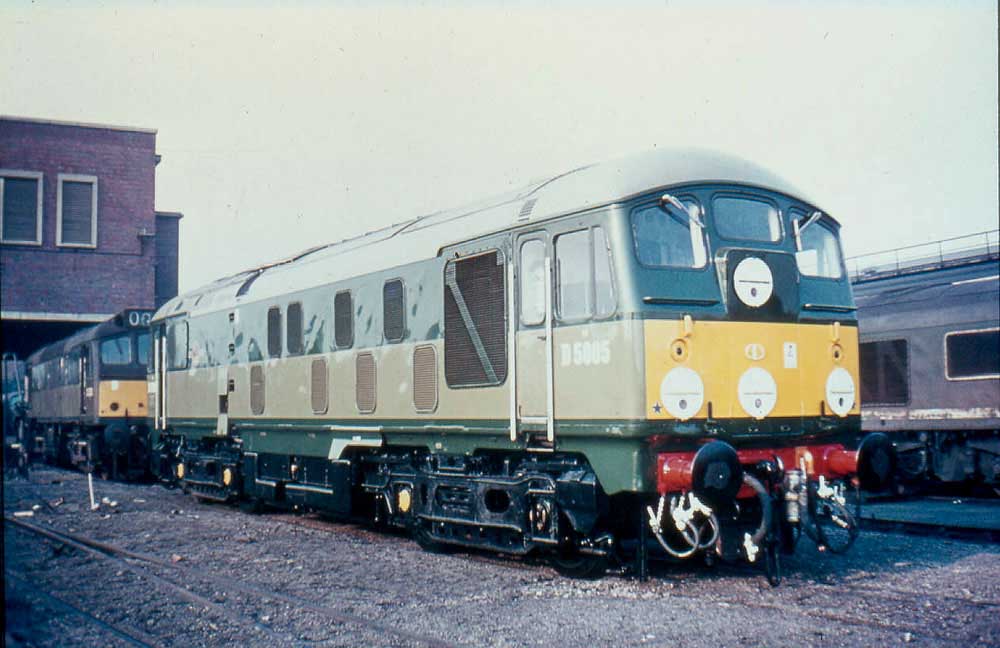
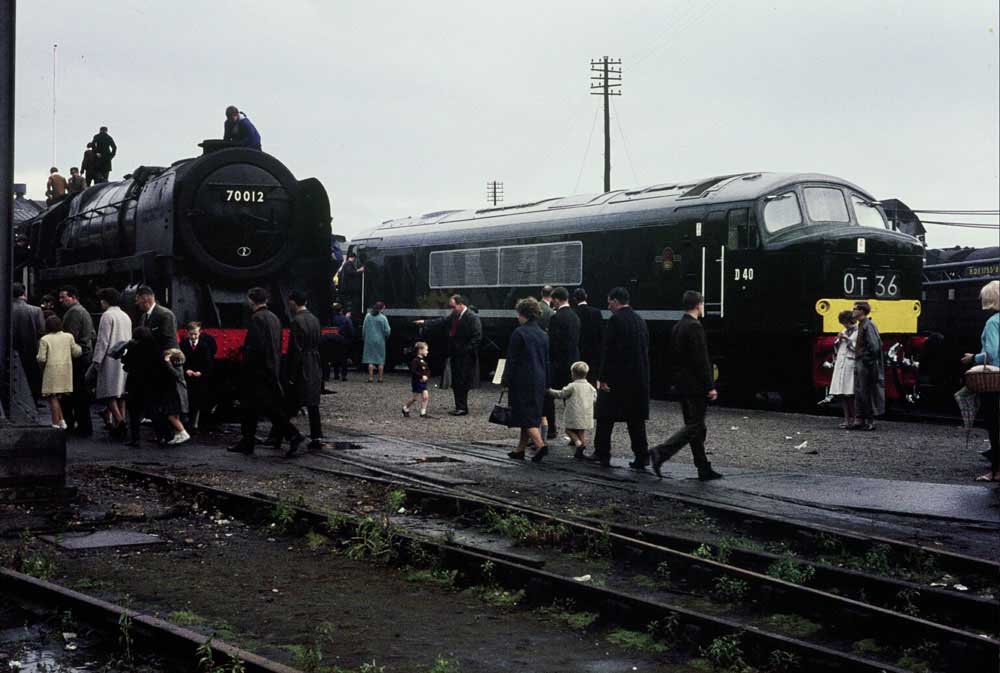
As November came to a close 10001 was still in the diesel repair shop receiving attention. The locomotive classes now receiving attention were very much focused on four types, the BR/Sulzer Type 4's from all owning regions, the BR/Sulzer Type 2's, both the 1,160hp & 1,250hp types, primarily LMR allocated machines but also some from the North Eastern Region depots and the BR's standard 350hp 0-6-0 shunter with examples received from most Regions for repair, though the LMR allocations would be dominant. The LMR allocated BRCW Type 2's were also Derby's responsibility, as were some of the now diminishing shunter classes. The Type 2 production line had reached D7601 whilst newly built Beyer Peacock example D7634 had been recieved for collision repairs.
Locomotives present at Derby Locomotive Works and yard on December 5th included:
D12, D14, D28, D30, D35, D40, D44, D57, D60, D65, D73, D75, D76, D87, D99
D108, D117, D124
D171, D191
D2218
D2504, D2513
D2907
D3051, D3057, D3068, D3115, D3124, D3126, D3696, D3778, D3785, D3786, D3787, D3791, D3796, D3843, D3858, D3861
D5054, D5063, D5087
D5135
D5166, D5167
D5268, D5298
D5379, D5383, D5384, D5388
D5401
D7562, D7564, D7566, D7567, D7576, D7588, D7598, D7599
D7600, D7601, D7602
10000*, 10001
10201*, 10202*, 10203*
12016, 12039, 12040, 12048, 12068, 12075
ED2, ED4, ED5
* = withdrawn
![]()
1966
At the beginning of February there were about seventy locomotives awaiting repair or scrapping, over a third of these locomotives were in the Klondyke sidings awaiting entry into the Works. New Type 2 construction was D7600 - D7609.
By mid-March Type 2 construction was up to D7614. A reassignment of smaller shunters from the Eastern Region to the London Midland Region may have been the cause for the entry of D2507/11/13 into the Works for repair. The continued contract repairs by Brush, Loughborough kept the later series BR/Sulzer Type 4's in Derby Works to a minimum, at this time only D160/170/175 were present.
D1 was noted receiving attention in the Works during April, other 'early' build diesels were represented by D2909, D5001 & 12003. New Type 2 production had reached D7621.
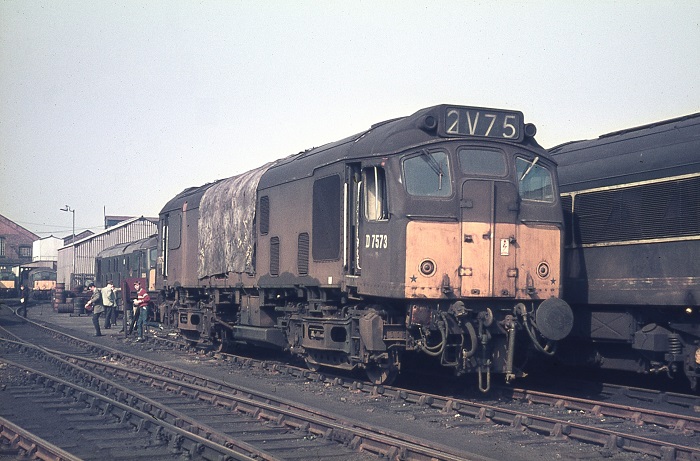
By late May Derby had laid down what was expected to be its final Type 2 build, that of D7623 (D7624 - D7659 had been constructed by Beyer Peacock). However Beyer Peacock asked to be relieved of their final eighteen locomotives, so D7660 - D7677 were transfered back to Derby with the frames for D7660 (order 11001) being laid during May. Yet another fairly new Beyer Peacock machine turned up at Derby for accident repairs, this one being D7643. The Works was also host to many Gateshead based Type 2's for repair - D5105, D5109 & D5111, no doubt due to the final closure of Darlington Works during April.
At the end of June Type 2 production had reached D7665. Locomotives under repair included twenty one BR/Sulzer Type 4's and eleven of the 1,160hp Type 2's. BRCW Type 2's under repair included D5377, D5404/13 whilst withdrawn D5383 was still present.
Type 2 production had reached D7667 by the end of July. In the Works storages lines were brand new D7617 - D7623 awaiting delivery to the Scottish Region, but delayed at Derby for some reason. Also in the deadlines were shunters D3121/22/23/24/26. These were part of a 1955 built batch (D3117 - D3126) of the standard 350hp 0-6-0 but powered by a Crossley six cylinder engine rather than the English Electric 6KT found in the vast majority of the class. These Crossley powered shunters were also equipped with Crompton Parkinson traction motors.
Locomotives present at the Open Day on August 27th included:
Exhibition Area:
48350, 70028, 92118
D105, D1947, D2381, D7622, D8155
12070.
Main Erecting Shop:
D10
D27, D60, D70, D79, D83, D88, D94, D122, D127
D2208, D2225
D2909, D2911
D3116, D3777, D3791
D5009, D5026, D5031, D5067, D5070, D5102
D5161, D5171
D5197, D5206, D5251
D5389, D5400
D7661 - D7668 under construction
12037, 12089.
D5154, D5149 - alongside main erecting shop?
Works Yard (1):
D2511, 12012.
Test House:
D5375, D5177, D180.
Works Yard (2):
D20
D3122, D3123
10000, 10201, 10202, 10203.
Works Yard (3):
ED2, ED4, ED5
D24, D43, D95
D2220
D2509, D2513
D3015, D3124, D3126, D4143
D5083
D5151
D5180
D5383
D7500, D7550, D7610, D7623
12022 withdrawn, 12053, 12058, 12090.
Compared to previous years the construction of the new Type 2s had slowed down quite considerably, the production line at the beginning of September had reached D7669, at about two a month the final Type 2s would be delivered sometime early in 1967. Perhaps the seventy odd diesel locomotives under repair had a higher priority. Older series 350hp 0-6-0 shunters in the Works included 12012/22/37/53/58/60/70/89/90.
On Sunday September 18th the following Type 2s were at Derby Locomotive Works:
Class 24: D5026, D5031, D5063, D5067, D5075, D5083, D5085, D5138, D5139 & D5149.
Class 25/0: D5154, D5155, D5161.
Class 25/1,2,3: D5180, D5186, D5206, D5215, D5245, D5251, D7512, D7550, D7561 & D7610.
Class 25 new build: D7660 - D7664.
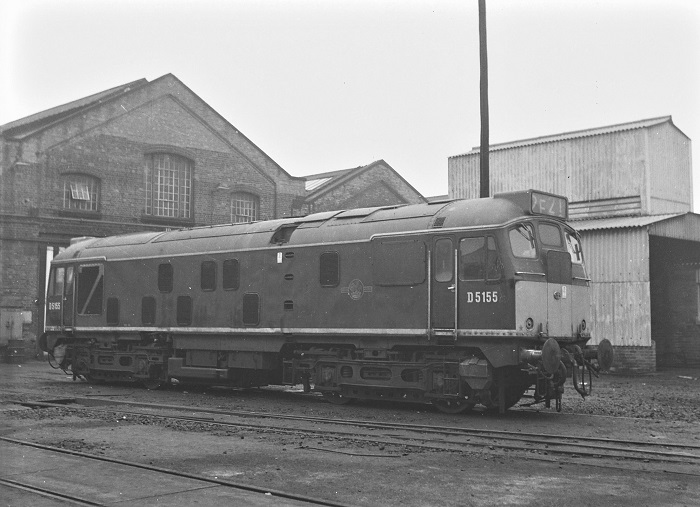
By early October the first Type 2 of the final order, D7660 was almost ready for release from the Works. It was in the new blue livery and displayed the new BR emblem. It would take a little while for Derby to get the livery correct. Elsewhere the frames had been laid up to D7671. Also in the Works was pioneer D5000 still carrying its unique original green, lined livery, it was one of ten of the 1,160hp Type 2's under repair in the Works.
A trip round the Works in November found quite a selection of withdrawn or soon to be withdrawn locomotives awaiting disposal, examples included D3122/23/24/26, D5383, 15000/15001, ED2/4/5, 10000, 10201 - 10203, 12022, D2509. New construction had now reached D7672.
Christmas 1966 at Derby Works found about eighty locomotives either under repair, new builds or awaiting scrapping. Derby's 1,000th diesel had now been officially recognised by plaques being fitted to D7667, construction had reached D7676, just one more set of frames to go. Perhaps the most unusual visitor in the works was D2857 for repair.
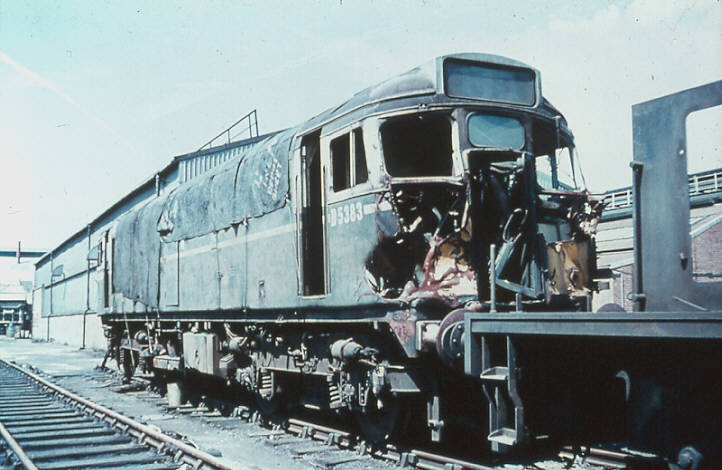
![]()
1967
During January the frames were laid for the last diesel locomotive to be constructed at Derby, D7677. With the new diesel build winding down Derby would continue with its repair of the BR/Sulzer Type 2's & 4's and the 350hp 0-6-0 shunters. Other classes of shunters would continue to be repaired here but as these classes dwindled, particularly those allocated to the London Midland Region, so these repairs would slacken. And Derby was currently not a big scrapper of withdrawn locomotives. Although the LMR allocated BRCW Type 2's continued to be repaired at Derby, a surprise visitor was Eastfield based D5350, which would normally have been dealt with by St Rollox Works, Glasgow.
The first of the early Type 4's to receive blue livery was D4, noted at the Works during January, the noses carried the small yellow ends and the livery was unlined.
The Repair shop was at this time empty whilst it underwent some type of reconstruction.
By the middle of March Derby's final Type 2, D7677 was looking very much like a locomotive, with the powerunit already fitted to the body. Also in the Works was the first built of the BR/Sulzer Type 2's, D5000. There was also a large contingent of the smaller 204hp shunters for repair, D2209/13/18/53/74 & D2378/88/94.
April saw the final outshopping of the last two new Type 2's, D7676 & D7677, leaving the Works with no new diesel locomotive construction after over a decade. There were approximately fifty locomotives in for repair in addition to the long stored withdrawn locomotives. Shunters of note under repair were D2852 & D2863.
By May the reconstruction of the Repair shop had been completed and locomotives were once again under repair here. Noteworthy visitors for repair were 0-6-0 204hp shunters D2117/18/24, all recently transferred from the Western Region to Derby (16C), though they would not remain here long, being soon sent north to the Carlisle area. The Works yard still contained sixteen withdrawn locomotives, many having been on site for several years.
A visit to Derby towards the end of June found no BRCW Type 2's under repair although there was quite a variety of shunters under repair.
It was time for a clean out of Derby Works during July, their lack of interest in cutting up locomotives at this time led to the withdrawn locomotives being put out to tender. Sold to J. Cashmore, Great Bridge were Crossley engine fitted D3123/24/26, accident damaged D5383 and ED4/5, 12022 & 15001. To Graham Harris & Elton, Chesterfield went D3122 and to Barborough Metals, Rotherham went shunters D2501/07/17.
ED4/5, 12022 & 15001 left Derby for the last time on August 10th bound for Cashmore's, Great Bridge.
Present for the 20th Annual Locomotive Works Open Day on August 26th were:
Display area in front of the office block: D7643 & 70013 Oliver Cromwell
Main repair shop: D11/17/18/43/51/61/85/86, D116/119/120/126, D5015/88/90, D5170, D5218/20/27/31/52, D7657, 12085
Finishing Shop: D186 and three unidentified Class 45/46's
Old Paint Shop: D5239
Klondyke sidings: D166, D2225, D2385, D3035, D3117/198, D4134/150, D5237/75, 15003, ED2
Test House area: D65, D106, D5091, D5234
New Repair Shop: D2199, D2208, D3028/89, D3122/93, D3979, D4147, 12062, 12101/112
Arrivals to Derby in late September included withdrawn 15101 - 15106, joing retired D2515 & 15003 in the Works yard. BRCW Type 2's under repair included D5384 & D5408. Despite the downsizing of the shunter fleet, those on the Works still provided quite a variety, including D2203, D2506, D2855 & 12038 in addition to the previously mentioned withdrawn types.
A strange visitor to Derby shed late in 1967 was withdrawn B1 4-6-0 No. 61262 travelling from Dunfermline to Crewe Works. On November 21st it was towed into the Works yard, but then removed to the shed the next day. It remained on the shed at least until late March 1968.
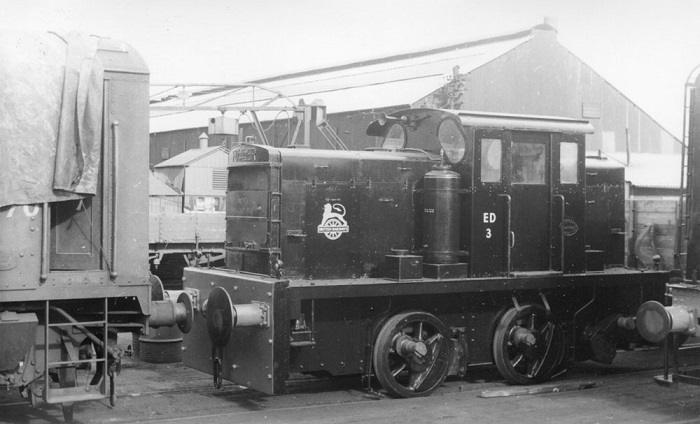
![]()
1968
A new type to visit Derby during the third week of January was HS4000, sent up from the Brush Works at Loughborough for weighing.
Also of importance during January was the sale of 10000, 10201, 10202 & 10203 to J Cashmore, Great Bridge. 10000 had spent six years dumped at Derby, the ex-Southern Region diesels almost as long! By early February these pioneers had been removed from Derby Works.
Visitors to the Works in April would find about fifty locomotives under repair, comprised of three main types, the BR/Sulzer Type 2's & 4's and the standard 0-6-0 350hp shunters. For a while longer the LMR allocated BRCW Type 2's would continue to visit the Works as would occasional examples of the other shunter types. The future for repair work at Derby would change little in the next decade.
Shunters visiting Derby during May were D2851 & D2864 and 12048/82 & 12100.
With steam on British Railways just about finished a new locomotive Classification system was brought in. For the diesels coming through Derby Works the BR Sulzer Type 2's would become the Classes 24 & 25, the BRCW Type 2's would become the Class 27's, the BR/Sulzer Type 4's would become Classes 44/45/46 and the ubiquitous 0-6-0 350hp shunters would become Classes 08 & 09. And along with these changes the use of the 'D' prefix was discontinued. During July the first of the LMR's Class 27's transfered north to Scotland, which would then see their repairs handled by Glasgow. Their place on the LMR would be filled by ex-Scottish Class 20's & 25's.
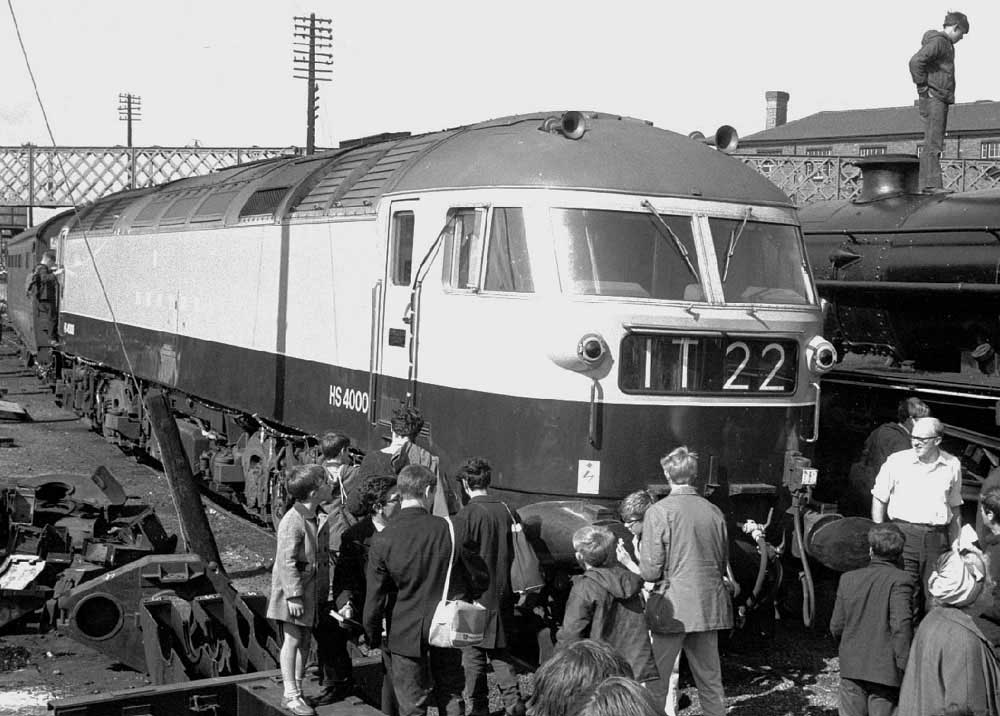
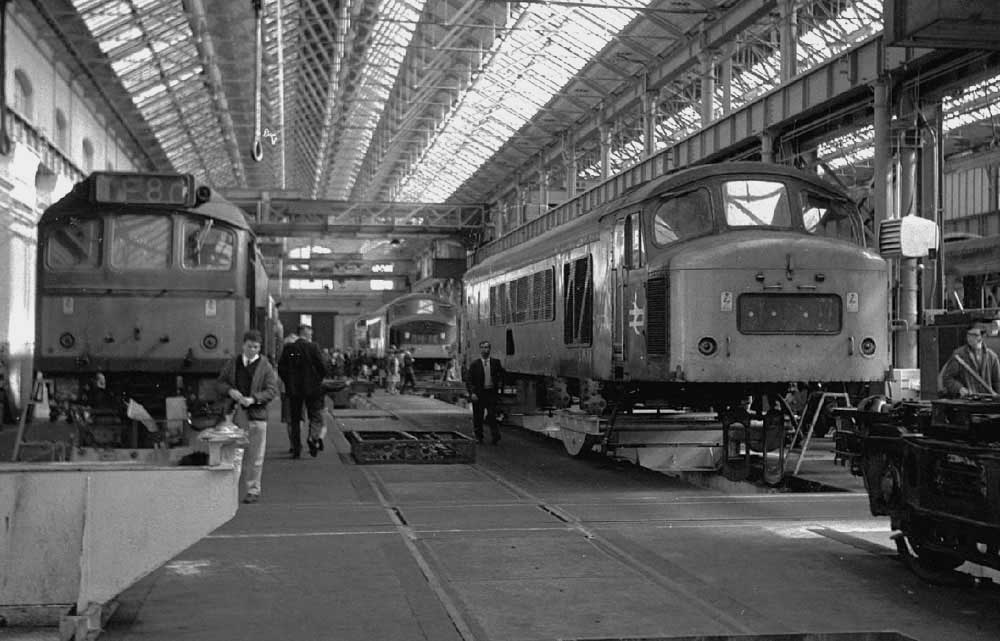
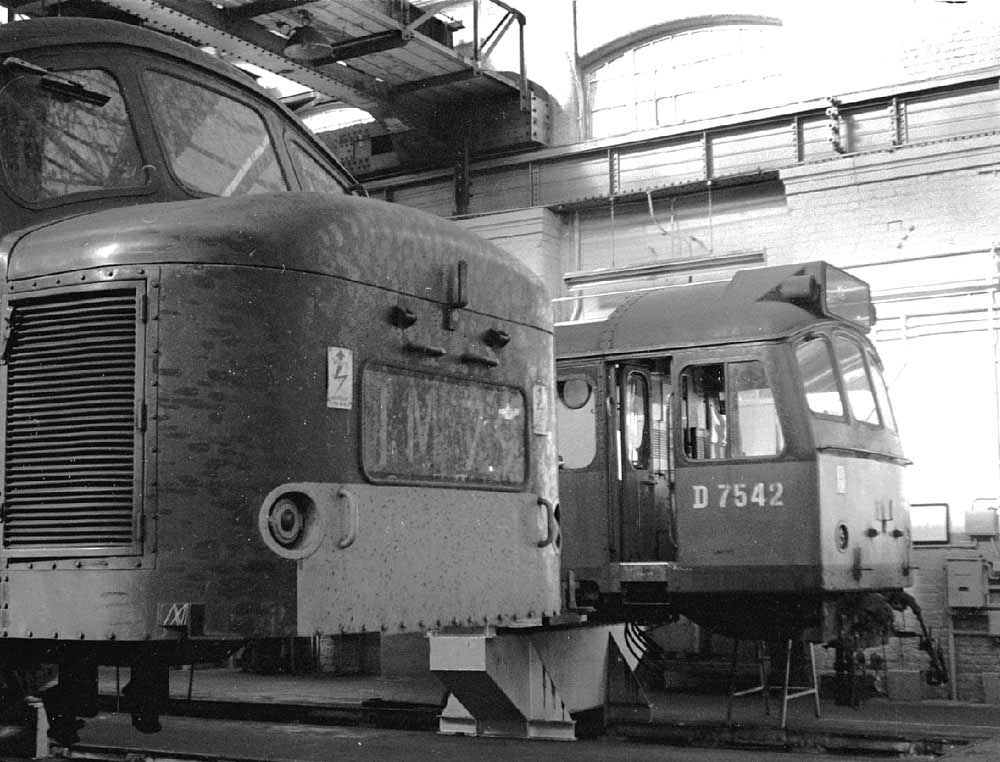
The 22nd annual Works Open Day took place on August 31st and those locomotives on display in front of the Works offices were:
44888, D55, D3292, D5157 & HS4000 Kestrel (see view above).
Locomotives noted in 8 & 9 Shop were:
41, 75, 99, 107, 113, 134, 135
157, 173, 177
5028, 5061
5174
7508, 7531, 7542, 7625.
Possibly because of the Works holiday the Works Yard, Klondyke sidings and the Test House area were empty. 44888 would remain on the Works for quite a while. Earlier in the month about forty locomotives had been under repair. It should also be noted that not every locomotive going through the Works would receive the corporate blue & yellow livery, many would still return to traffic in green livery. Programmes for the Open Day cost six old pence.
Late in September one of the first locomotives to be outshopped from Derby without the 'D' prefix was Class 08 3181, which also received blue livery.
Steam locomotive 44888 was still present in the Works during early November.
![]()
1969
During January four Stoke Division (D05) allocated Class 24's were retired, D5001/05/10/19. This reflected a surplus of lower powered locomotives on British Railway, withdrawals had already seen several less successful Modernisation Plan types go to the wall and the withdrawal of many of the early builds of several types. Of the four withdrawn, one, D5005 was quickly moved to Derby Works and soon reduced to little more than a shell by the end of March. Derby was of course still repairing the Class 24's, but at this time none of the original build apart from D5005 were in the Works. An unusual visitor to the Works yard was Southern Region Class 33, 6570 connected to a steam tender - this combination was presumably under the guidance of the Research Center.
By June several other Class 24's had been withdrawn or stored, of these only 5004 had reached Derby Works. Another Class 24 at Derby with accident damage was 5090. There were about forty locomotives on Works, with the Class 44/45/46 and Class 08's predominating. Class 27's under repair included 5373 & 5397.
The 23rd annual Works Open Day took place on August 30th, programmes cost six old pence.
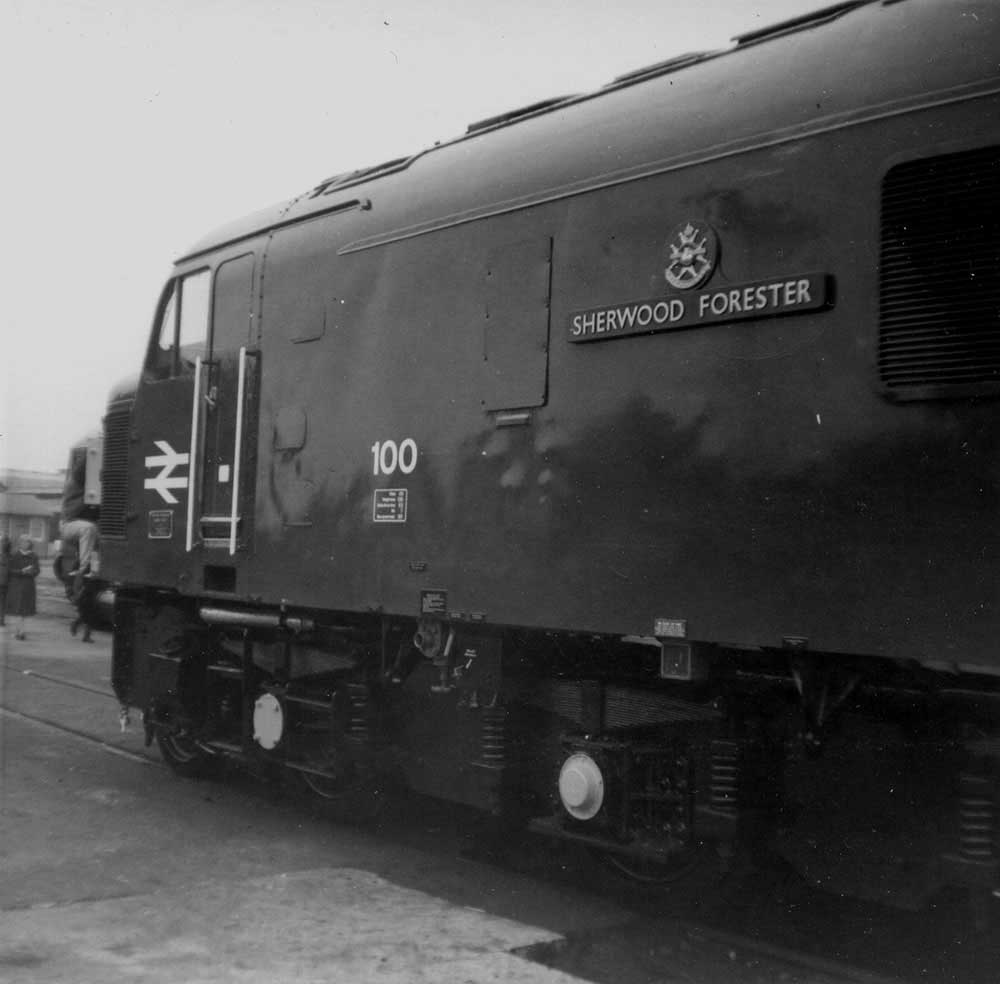
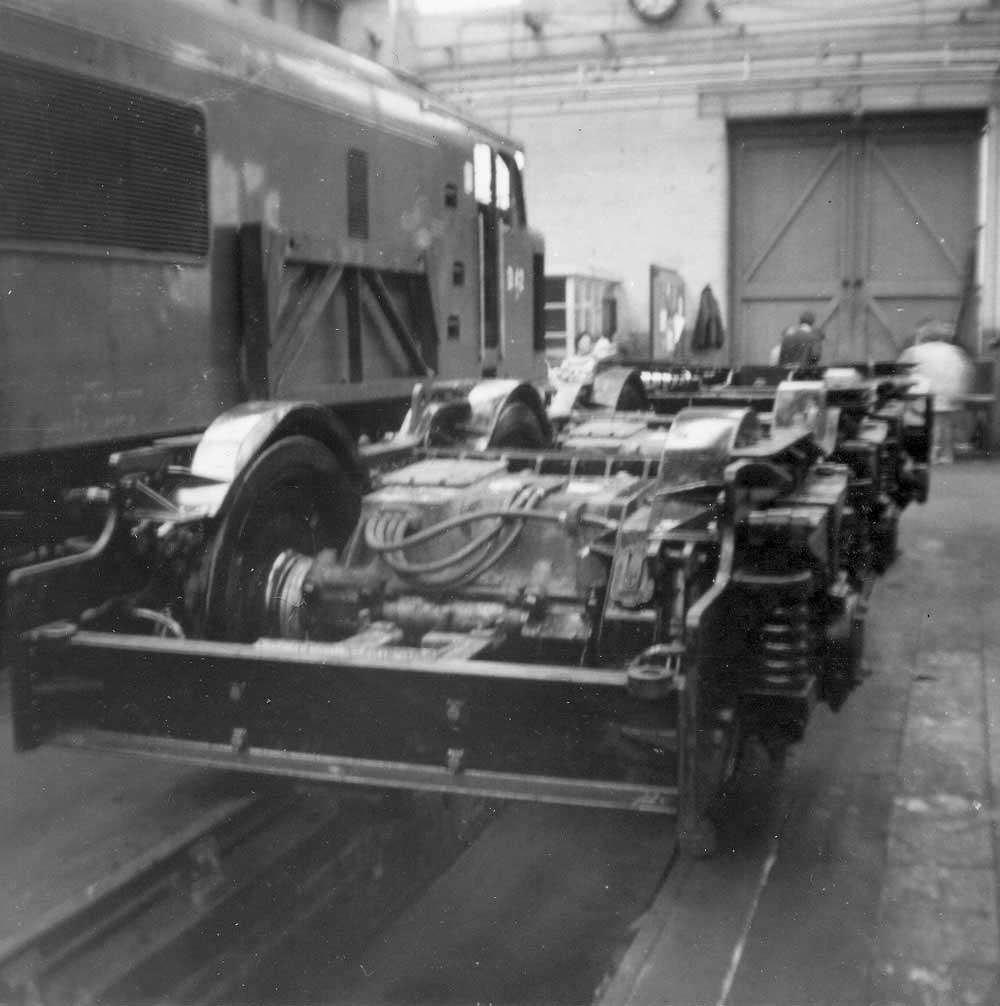
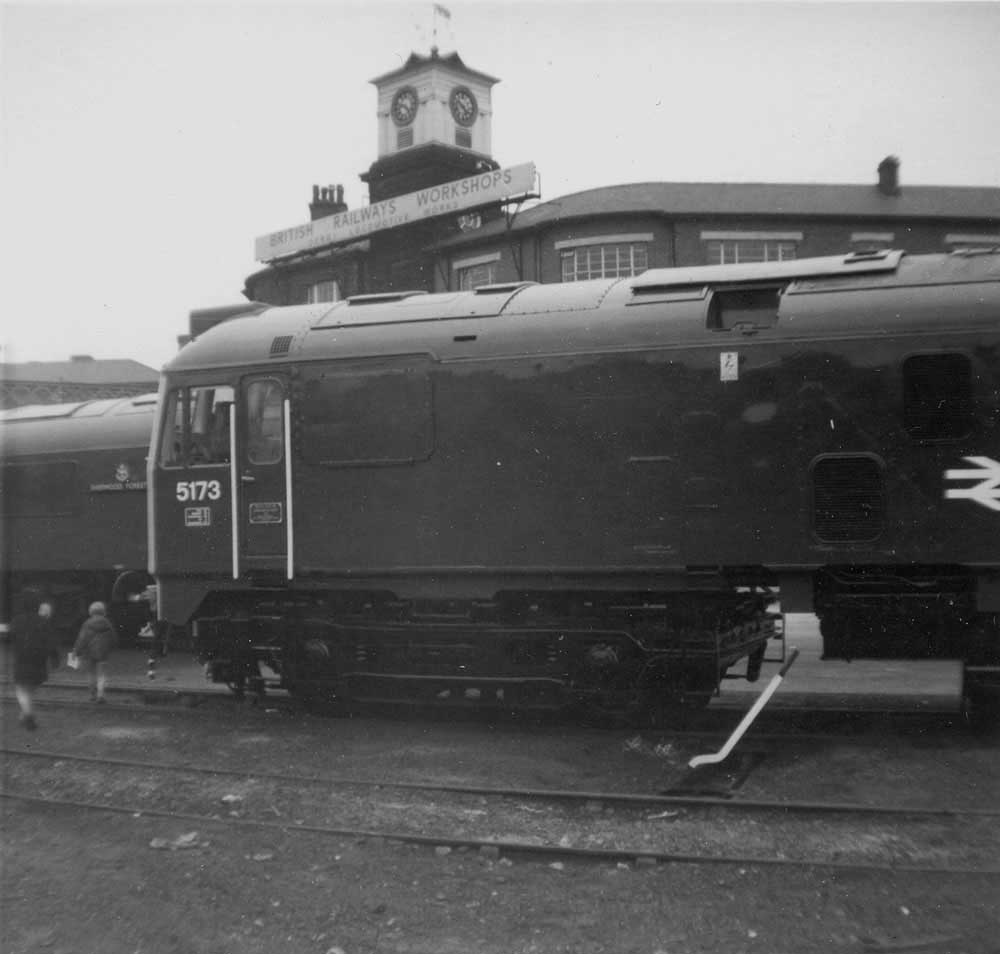
A serious accident at Chester and a shortage of locomotives on the Eastern Region allowed the reinstatement of all the withdrawn and stored Class 24's with the exception of 5005 which was now little more than a shell at Derby Works. During September 5001 and 5090 were receiving repairs at Derby. Also in the Works were 12069 & 12080.
During October the Works contained about forty locomotives, the recent transfer of more Class 27's to Scotland would see less of this type undergoing repair at Derby, still present were 5377/81/85/88, of these 5385 was one of those recently transfered to Eastfield.
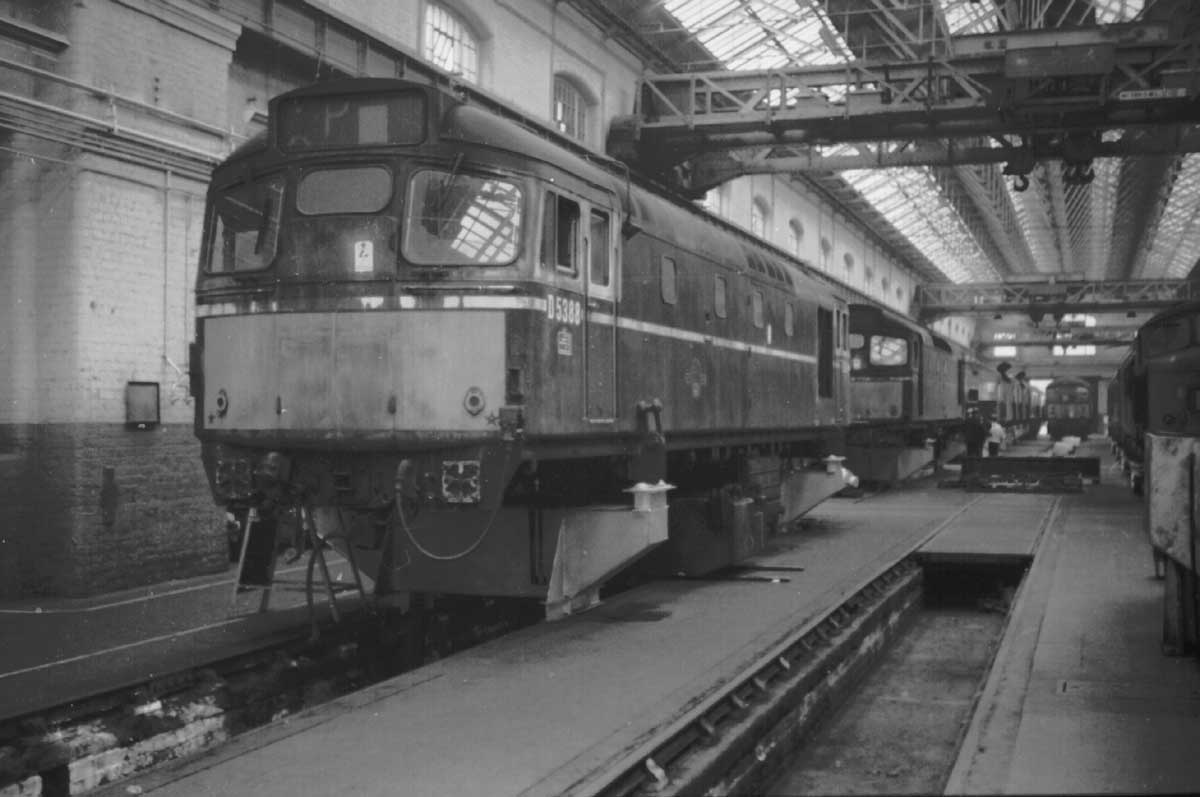
![]()
Page added October 22nd 2007.
Last updated May 19th 2024.
Derby Works 1932 - 1950
Derby Works 1950 - 1959
Derby Works 1970 - 1975
Derby Works 1976 - 1980
Derby Works 1981 - 1983
Derby Works 1984 - 2007